Healthcare in the Region of Auckland in New Zealand Research Paper 2022
VerifiedAdded on 2022/09/29
|27
|7654
|32
AI Summary
Contribute Materials
Your contribution can guide someone’s learning journey. Share your
documents today.
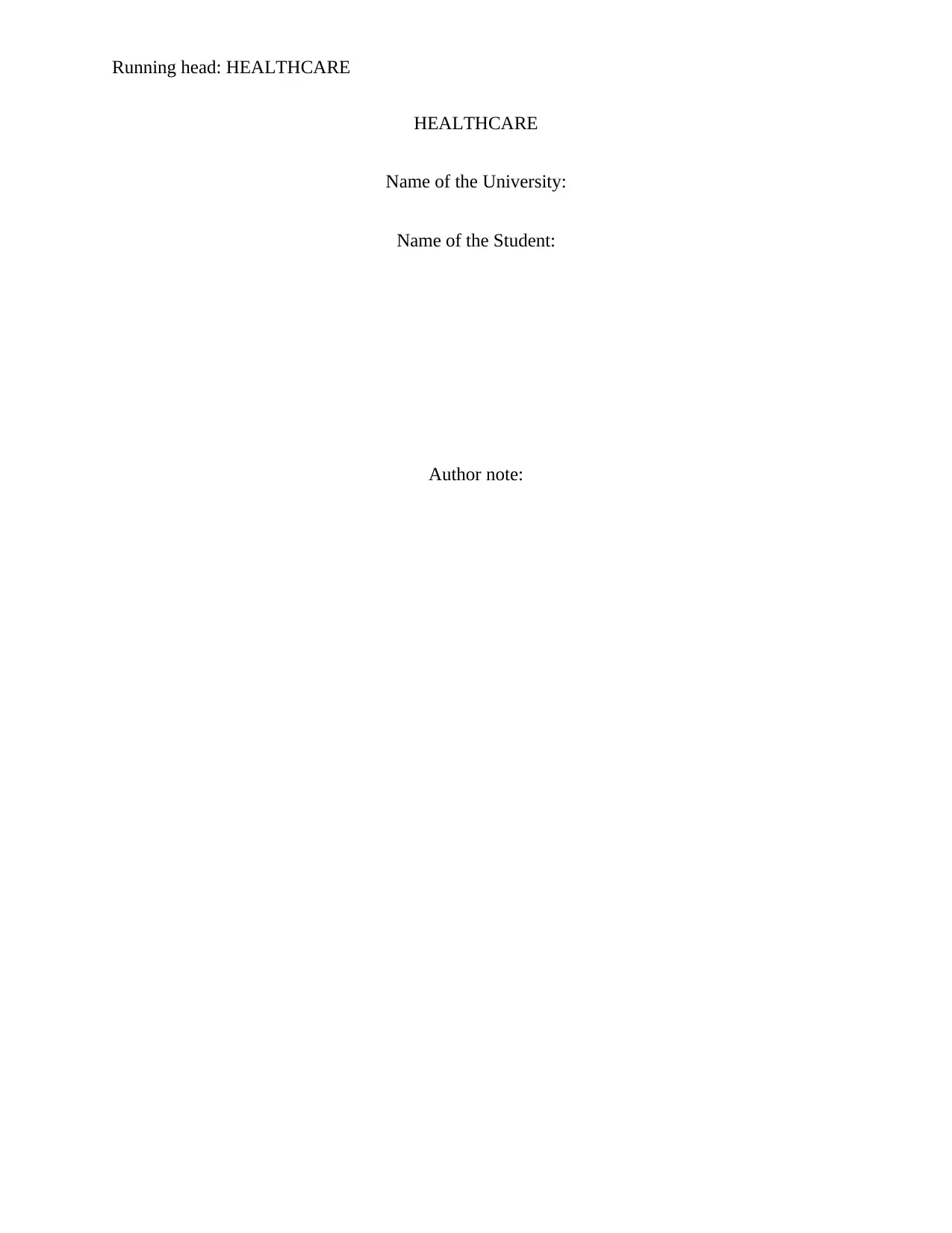
Running head: HEALTHCARE
HEALTHCARE
Name of the University:
Name of the Student:
Author note:
HEALTHCARE
Name of the University:
Name of the Student:
Author note:
Secure Best Marks with AI Grader
Need help grading? Try our AI Grader for instant feedback on your assignments.
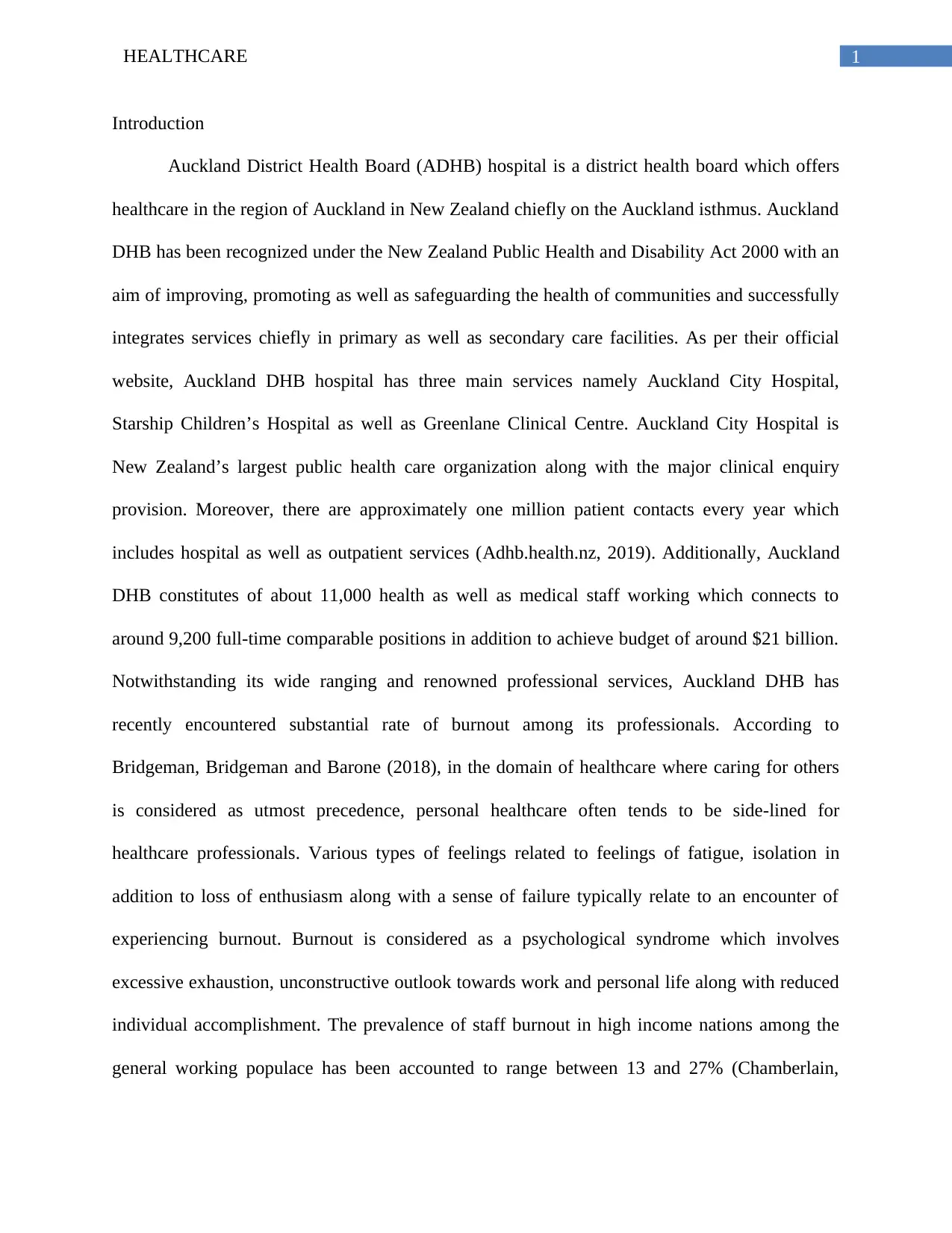
1HEALTHCARE
Introduction
Auckland District Health Board (ADHB) hospital is a district health board which offers
healthcare in the region of Auckland in New Zealand chiefly on the Auckland isthmus. Auckland
DHB has been recognized under the New Zealand Public Health and Disability Act 2000 with an
aim of improving, promoting as well as safeguarding the health of communities and successfully
integrates services chiefly in primary as well as secondary care facilities. As per their official
website, Auckland DHB hospital has three main services namely Auckland City Hospital,
Starship Children’s Hospital as well as Greenlane Clinical Centre. Auckland City Hospital is
New Zealand’s largest public health care organization along with the major clinical enquiry
provision. Moreover, there are approximately one million patient contacts every year which
includes hospital as well as outpatient services (Adhb.health.nz, 2019). Additionally, Auckland
DHB constitutes of about 11,000 health as well as medical staff working which connects to
around 9,200 full-time comparable positions in addition to achieve budget of around $21 billion.
Notwithstanding its wide ranging and renowned professional services, Auckland DHB has
recently encountered substantial rate of burnout among its professionals. According to
Bridgeman, Bridgeman and Barone (2018), in the domain of healthcare where caring for others
is considered as utmost precedence, personal healthcare often tends to be side-lined for
healthcare professionals. Various types of feelings related to feelings of fatigue, isolation in
addition to loss of enthusiasm along with a sense of failure typically relate to an encounter of
experiencing burnout. Burnout is considered as a psychological syndrome which involves
excessive exhaustion, unconstructive outlook towards work and personal life along with reduced
individual accomplishment. The prevalence of staff burnout in high income nations among the
general working populace has been accounted to range between 13 and 27% (Chamberlain,
Introduction
Auckland District Health Board (ADHB) hospital is a district health board which offers
healthcare in the region of Auckland in New Zealand chiefly on the Auckland isthmus. Auckland
DHB has been recognized under the New Zealand Public Health and Disability Act 2000 with an
aim of improving, promoting as well as safeguarding the health of communities and successfully
integrates services chiefly in primary as well as secondary care facilities. As per their official
website, Auckland DHB hospital has three main services namely Auckland City Hospital,
Starship Children’s Hospital as well as Greenlane Clinical Centre. Auckland City Hospital is
New Zealand’s largest public health care organization along with the major clinical enquiry
provision. Moreover, there are approximately one million patient contacts every year which
includes hospital as well as outpatient services (Adhb.health.nz, 2019). Additionally, Auckland
DHB constitutes of about 11,000 health as well as medical staff working which connects to
around 9,200 full-time comparable positions in addition to achieve budget of around $21 billion.
Notwithstanding its wide ranging and renowned professional services, Auckland DHB has
recently encountered substantial rate of burnout among its professionals. According to
Bridgeman, Bridgeman and Barone (2018), in the domain of healthcare where caring for others
is considered as utmost precedence, personal healthcare often tends to be side-lined for
healthcare professionals. Various types of feelings related to feelings of fatigue, isolation in
addition to loss of enthusiasm along with a sense of failure typically relate to an encounter of
experiencing burnout. Burnout is considered as a psychological syndrome which involves
excessive exhaustion, unconstructive outlook towards work and personal life along with reduced
individual accomplishment. The prevalence of staff burnout in high income nations among the
general working populace has been accounted to range between 13 and 27% (Chamberlain,
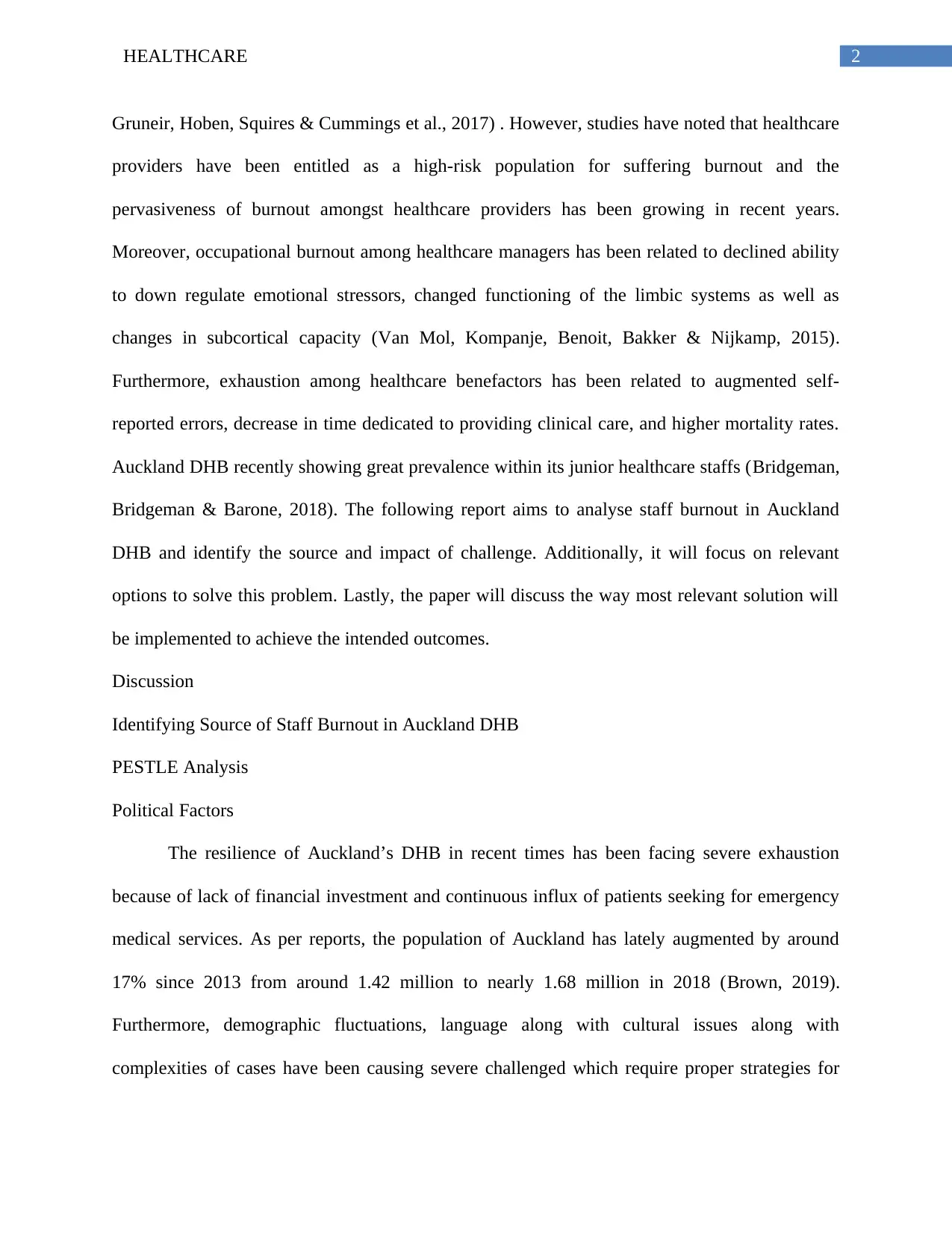
2HEALTHCARE
Gruneir, Hoben, Squires & Cummings et al., 2017) . However, studies have noted that healthcare
providers have been entitled as a high-risk population for suffering burnout and the
pervasiveness of burnout amongst healthcare providers has been growing in recent years.
Moreover, occupational burnout among healthcare managers has been related to declined ability
to down regulate emotional stressors, changed functioning of the limbic systems as well as
changes in subcortical capacity (Van Mol, Kompanje, Benoit, Bakker & Nijkamp, 2015).
Furthermore, exhaustion among healthcare benefactors has been related to augmented self-
reported errors, decrease in time dedicated to providing clinical care, and higher mortality rates.
Auckland DHB recently showing great prevalence within its junior healthcare staffs (Bridgeman,
Bridgeman & Barone, 2018). The following report aims to analyse staff burnout in Auckland
DHB and identify the source and impact of challenge. Additionally, it will focus on relevant
options to solve this problem. Lastly, the paper will discuss the way most relevant solution will
be implemented to achieve the intended outcomes.
Discussion
Identifying Source of Staff Burnout in Auckland DHB
PESTLE Analysis
Political Factors
The resilience of Auckland’s DHB in recent times has been facing severe exhaustion
because of lack of financial investment and continuous influx of patients seeking for emergency
medical services. As per reports, the population of Auckland has lately augmented by around
17% since 2013 from around 1.42 million to nearly 1.68 million in 2018 (Brown, 2019).
Furthermore, demographic fluctuations, language along with cultural issues along with
complexities of cases have been causing severe challenged which require proper strategies for
Gruneir, Hoben, Squires & Cummings et al., 2017) . However, studies have noted that healthcare
providers have been entitled as a high-risk population for suffering burnout and the
pervasiveness of burnout amongst healthcare providers has been growing in recent years.
Moreover, occupational burnout among healthcare managers has been related to declined ability
to down regulate emotional stressors, changed functioning of the limbic systems as well as
changes in subcortical capacity (Van Mol, Kompanje, Benoit, Bakker & Nijkamp, 2015).
Furthermore, exhaustion among healthcare benefactors has been related to augmented self-
reported errors, decrease in time dedicated to providing clinical care, and higher mortality rates.
Auckland DHB recently showing great prevalence within its junior healthcare staffs (Bridgeman,
Bridgeman & Barone, 2018). The following report aims to analyse staff burnout in Auckland
DHB and identify the source and impact of challenge. Additionally, it will focus on relevant
options to solve this problem. Lastly, the paper will discuss the way most relevant solution will
be implemented to achieve the intended outcomes.
Discussion
Identifying Source of Staff Burnout in Auckland DHB
PESTLE Analysis
Political Factors
The resilience of Auckland’s DHB in recent times has been facing severe exhaustion
because of lack of financial investment and continuous influx of patients seeking for emergency
medical services. As per reports, the population of Auckland has lately augmented by around
17% since 2013 from around 1.42 million to nearly 1.68 million in 2018 (Brown, 2019).
Furthermore, demographic fluctuations, language along with cultural issues along with
complexities of cases have been causing severe challenged which require proper strategies for
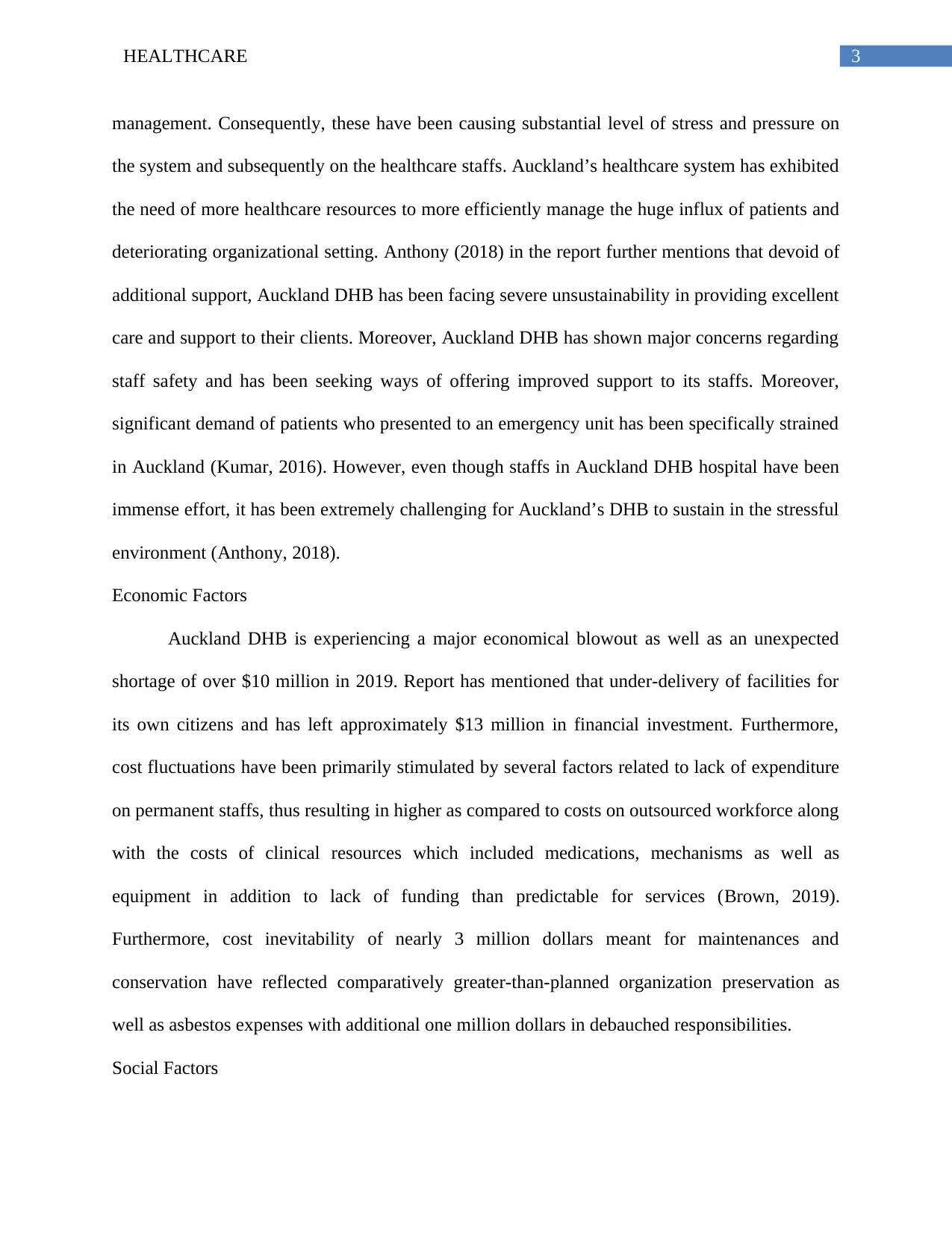
3HEALTHCARE
management. Consequently, these have been causing substantial level of stress and pressure on
the system and subsequently on the healthcare staffs. Auckland’s healthcare system has exhibited
the need of more healthcare resources to more efficiently manage the huge influx of patients and
deteriorating organizational setting. Anthony (2018) in the report further mentions that devoid of
additional support, Auckland DHB has been facing severe unsustainability in providing excellent
care and support to their clients. Moreover, Auckland DHB has shown major concerns regarding
staff safety and has been seeking ways of offering improved support to its staffs. Moreover,
significant demand of patients who presented to an emergency unit has been specifically strained
in Auckland (Kumar, 2016). However, even though staffs in Auckland DHB hospital have been
immense effort, it has been extremely challenging for Auckland’s DHB to sustain in the stressful
environment (Anthony, 2018).
Economic Factors
Auckland DHB is experiencing a major economical blowout as well as an unexpected
shortage of over $10 million in 2019. Report has mentioned that under-delivery of facilities for
its own citizens and has left approximately $13 million in financial investment. Furthermore,
cost fluctuations have been primarily stimulated by several factors related to lack of expenditure
on permanent staffs, thus resulting in higher as compared to costs on outsourced workforce along
with the costs of clinical resources which included medications, mechanisms as well as
equipment in addition to lack of funding than predictable for services (Brown, 2019).
Furthermore, cost inevitability of nearly 3 million dollars meant for maintenances and
conservation have reflected comparatively greater-than-planned organization preservation as
well as asbestos expenses with additional one million dollars in debauched responsibilities.
Social Factors
management. Consequently, these have been causing substantial level of stress and pressure on
the system and subsequently on the healthcare staffs. Auckland’s healthcare system has exhibited
the need of more healthcare resources to more efficiently manage the huge influx of patients and
deteriorating organizational setting. Anthony (2018) in the report further mentions that devoid of
additional support, Auckland DHB has been facing severe unsustainability in providing excellent
care and support to their clients. Moreover, Auckland DHB has shown major concerns regarding
staff safety and has been seeking ways of offering improved support to its staffs. Moreover,
significant demand of patients who presented to an emergency unit has been specifically strained
in Auckland (Kumar, 2016). However, even though staffs in Auckland DHB hospital have been
immense effort, it has been extremely challenging for Auckland’s DHB to sustain in the stressful
environment (Anthony, 2018).
Economic Factors
Auckland DHB is experiencing a major economical blowout as well as an unexpected
shortage of over $10 million in 2019. Report has mentioned that under-delivery of facilities for
its own citizens and has left approximately $13 million in financial investment. Furthermore,
cost fluctuations have been primarily stimulated by several factors related to lack of expenditure
on permanent staffs, thus resulting in higher as compared to costs on outsourced workforce along
with the costs of clinical resources which included medications, mechanisms as well as
equipment in addition to lack of funding than predictable for services (Brown, 2019).
Furthermore, cost inevitability of nearly 3 million dollars meant for maintenances and
conservation have reflected comparatively greater-than-planned organization preservation as
well as asbestos expenses with additional one million dollars in debauched responsibilities.
Social Factors
Secure Best Marks with AI Grader
Need help grading? Try our AI Grader for instant feedback on your assignments.
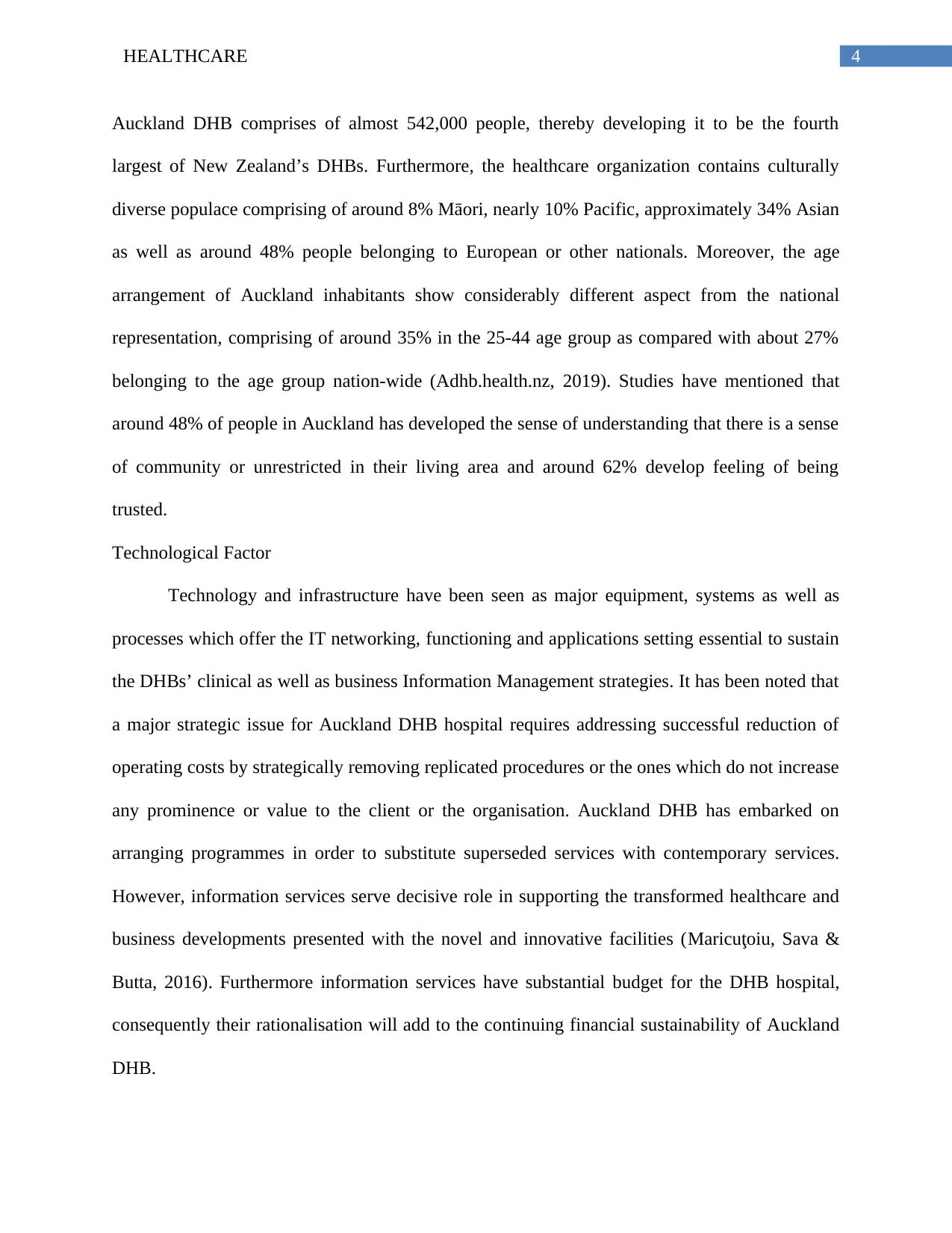
4HEALTHCARE
Auckland DHB comprises of almost 542,000 people, thereby developing it to be the fourth
largest of New Zealand’s DHBs. Furthermore, the healthcare organization contains culturally
diverse populace comprising of around 8% Māori, nearly 10% Pacific, approximately 34% Asian
as well as around 48% people belonging to European or other nationals. Moreover, the age
arrangement of Auckland inhabitants show considerably different aspect from the national
representation, comprising of around 35% in the 25-44 age group as compared with about 27%
belonging to the age group nation-wide (Adhb.health.nz, 2019). Studies have mentioned that
around 48% of people in Auckland has developed the sense of understanding that there is a sense
of community or unrestricted in their living area and around 62% develop feeling of being
trusted.
Technological Factor
Technology and infrastructure have been seen as major equipment, systems as well as
processes which offer the IT networking, functioning and applications setting essential to sustain
the DHBs’ clinical as well as business Information Management strategies. It has been noted that
a major strategic issue for Auckland DHB hospital requires addressing successful reduction of
operating costs by strategically removing replicated procedures or the ones which do not increase
any prominence or value to the client or the organisation. Auckland DHB has embarked on
arranging programmes in order to substitute superseded services with contemporary services.
However, information services serve decisive role in supporting the transformed healthcare and
business developments presented with the novel and innovative facilities (Maricuţoiu, Sava &
Butta, 2016). Furthermore information services have substantial budget for the DHB hospital,
consequently their rationalisation will add to the continuing financial sustainability of Auckland
DHB.
Auckland DHB comprises of almost 542,000 people, thereby developing it to be the fourth
largest of New Zealand’s DHBs. Furthermore, the healthcare organization contains culturally
diverse populace comprising of around 8% Māori, nearly 10% Pacific, approximately 34% Asian
as well as around 48% people belonging to European or other nationals. Moreover, the age
arrangement of Auckland inhabitants show considerably different aspect from the national
representation, comprising of around 35% in the 25-44 age group as compared with about 27%
belonging to the age group nation-wide (Adhb.health.nz, 2019). Studies have mentioned that
around 48% of people in Auckland has developed the sense of understanding that there is a sense
of community or unrestricted in their living area and around 62% develop feeling of being
trusted.
Technological Factor
Technology and infrastructure have been seen as major equipment, systems as well as
processes which offer the IT networking, functioning and applications setting essential to sustain
the DHBs’ clinical as well as business Information Management strategies. It has been noted that
a major strategic issue for Auckland DHB hospital requires addressing successful reduction of
operating costs by strategically removing replicated procedures or the ones which do not increase
any prominence or value to the client or the organisation. Auckland DHB has embarked on
arranging programmes in order to substitute superseded services with contemporary services.
However, information services serve decisive role in supporting the transformed healthcare and
business developments presented with the novel and innovative facilities (Maricuţoiu, Sava &
Butta, 2016). Furthermore information services have substantial budget for the DHB hospital,
consequently their rationalisation will add to the continuing financial sustainability of Auckland
DHB.
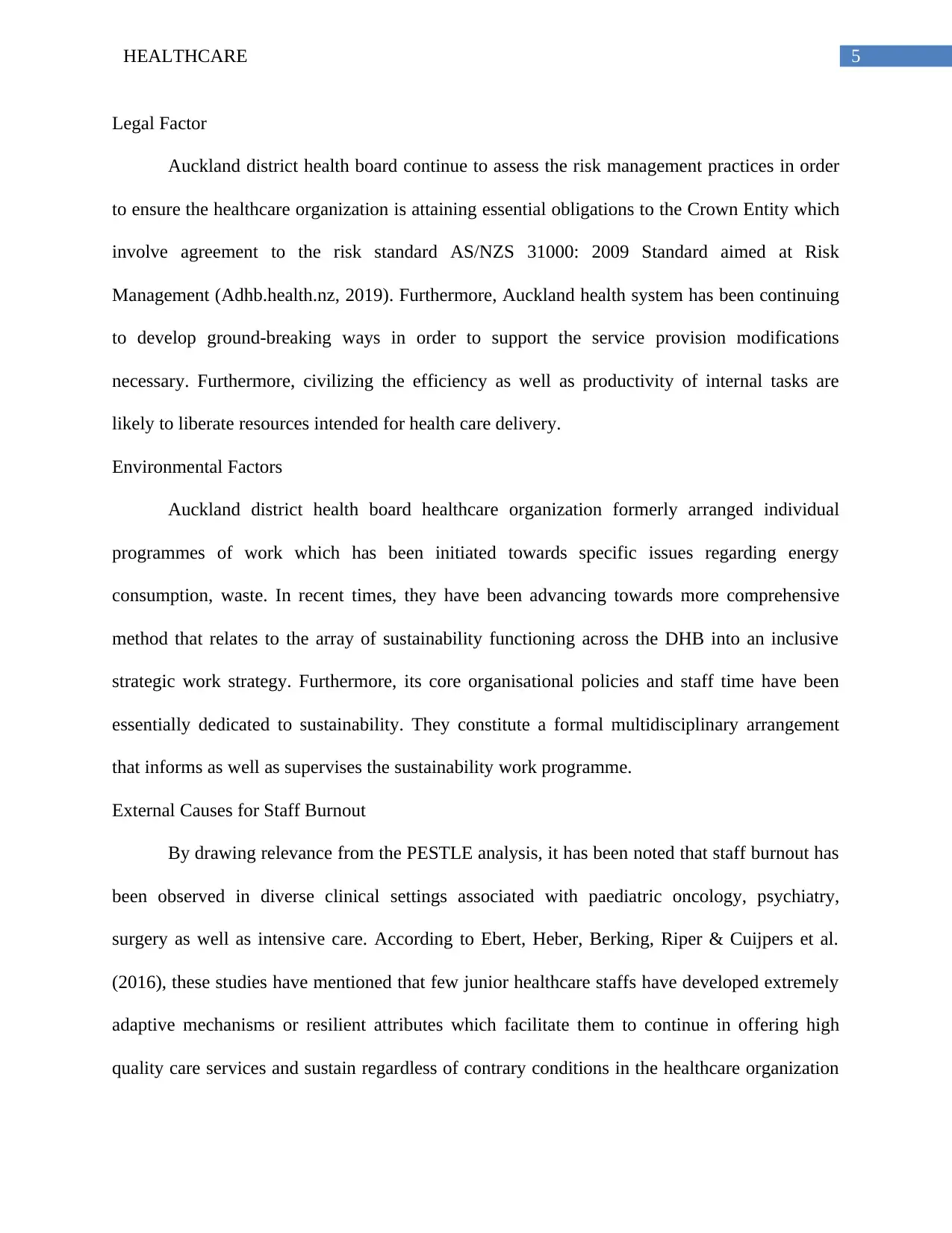
5HEALTHCARE
Legal Factor
Auckland district health board continue to assess the risk management practices in order
to ensure the healthcare organization is attaining essential obligations to the Crown Entity which
involve agreement to the risk standard AS/NZS 31000: 2009 Standard aimed at Risk
Management (Adhb.health.nz, 2019). Furthermore, Auckland health system has been continuing
to develop ground-breaking ways in order to support the service provision modifications
necessary. Furthermore, civilizing the efficiency as well as productivity of internal tasks are
likely to liberate resources intended for health care delivery.
Environmental Factors
Auckland district health board healthcare organization formerly arranged individual
programmes of work which has been initiated towards specific issues regarding energy
consumption, waste. In recent times, they have been advancing towards more comprehensive
method that relates to the array of sustainability functioning across the DHB into an inclusive
strategic work strategy. Furthermore, its core organisational policies and staff time have been
essentially dedicated to sustainability. They constitute a formal multidisciplinary arrangement
that informs as well as supervises the sustainability work programme.
External Causes for Staff Burnout
By drawing relevance from the PESTLE analysis, it has been noted that staff burnout has
been observed in diverse clinical settings associated with paediatric oncology, psychiatry,
surgery as well as intensive care. According to Ebert, Heber, Berking, Riper & Cuijpers et al.
(2016), these studies have mentioned that few junior healthcare staffs have developed extremely
adaptive mechanisms or resilient attributes which facilitate them to continue in offering high
quality care services and sustain regardless of contrary conditions in the healthcare organization
Legal Factor
Auckland district health board continue to assess the risk management practices in order
to ensure the healthcare organization is attaining essential obligations to the Crown Entity which
involve agreement to the risk standard AS/NZS 31000: 2009 Standard aimed at Risk
Management (Adhb.health.nz, 2019). Furthermore, Auckland health system has been continuing
to develop ground-breaking ways in order to support the service provision modifications
necessary. Furthermore, civilizing the efficiency as well as productivity of internal tasks are
likely to liberate resources intended for health care delivery.
Environmental Factors
Auckland district health board healthcare organization formerly arranged individual
programmes of work which has been initiated towards specific issues regarding energy
consumption, waste. In recent times, they have been advancing towards more comprehensive
method that relates to the array of sustainability functioning across the DHB into an inclusive
strategic work strategy. Furthermore, its core organisational policies and staff time have been
essentially dedicated to sustainability. They constitute a formal multidisciplinary arrangement
that informs as well as supervises the sustainability work programme.
External Causes for Staff Burnout
By drawing relevance from the PESTLE analysis, it has been noted that staff burnout has
been observed in diverse clinical settings associated with paediatric oncology, psychiatry,
surgery as well as intensive care. According to Ebert, Heber, Berking, Riper & Cuijpers et al.
(2016), these studies have mentioned that few junior healthcare staffs have developed extremely
adaptive mechanisms or resilient attributes which facilitate them to continue in offering high
quality care services and sustain regardless of contrary conditions in the healthcare organization
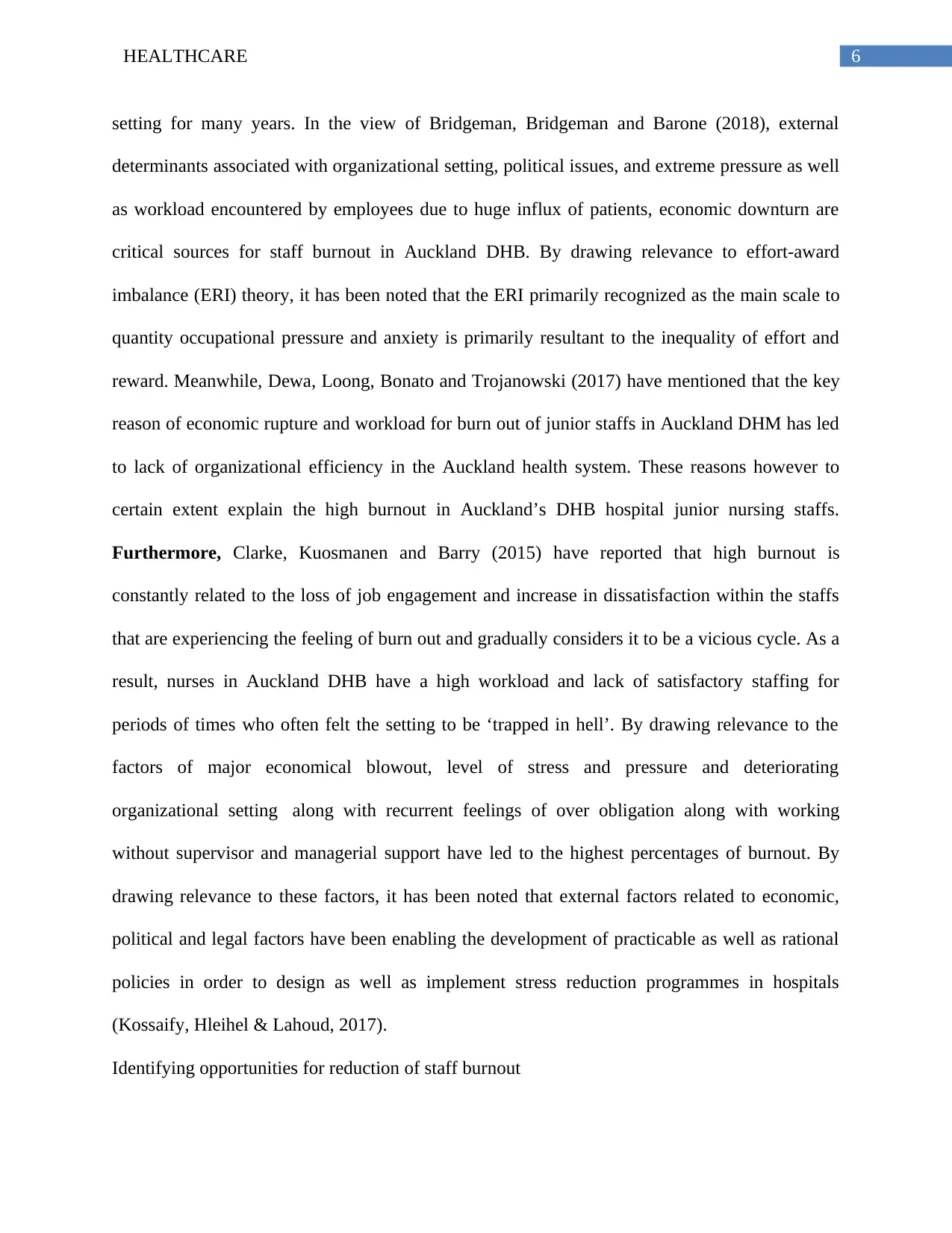
6HEALTHCARE
setting for many years. In the view of Bridgeman, Bridgeman and Barone (2018), external
determinants associated with organizational setting, political issues, and extreme pressure as well
as workload encountered by employees due to huge influx of patients, economic downturn are
critical sources for staff burnout in Auckland DHB. By drawing relevance to effort-award
imbalance (ERI) theory, it has been noted that the ERI primarily recognized as the main scale to
quantity occupational pressure and anxiety is primarily resultant to the inequality of effort and
reward. Meanwhile, Dewa, Loong, Bonato and Trojanowski (2017) have mentioned that the key
reason of economic rupture and workload for burn out of junior staffs in Auckland DHM has led
to lack of organizational efficiency in the Auckland health system. These reasons however to
certain extent explain the high burnout in Auckland’s DHB hospital junior nursing staffs.
Furthermore, Clarke, Kuosmanen and Barry (2015) have reported that high burnout is
constantly related to the loss of job engagement and increase in dissatisfaction within the staffs
that are experiencing the feeling of burn out and gradually considers it to be a vicious cycle. As a
result, nurses in Auckland DHB have a high workload and lack of satisfactory staffing for
periods of times who often felt the setting to be ‘trapped in hell’. By drawing relevance to the
factors of major economical blowout, level of stress and pressure and deteriorating
organizational setting along with recurrent feelings of over obligation along with working
without supervisor and managerial support have led to the highest percentages of burnout. By
drawing relevance to these factors, it has been noted that external factors related to economic,
political and legal factors have been enabling the development of practicable as well as rational
policies in order to design as well as implement stress reduction programmes in hospitals
(Kossaify, Hleihel & Lahoud, 2017).
Identifying opportunities for reduction of staff burnout
setting for many years. In the view of Bridgeman, Bridgeman and Barone (2018), external
determinants associated with organizational setting, political issues, and extreme pressure as well
as workload encountered by employees due to huge influx of patients, economic downturn are
critical sources for staff burnout in Auckland DHB. By drawing relevance to effort-award
imbalance (ERI) theory, it has been noted that the ERI primarily recognized as the main scale to
quantity occupational pressure and anxiety is primarily resultant to the inequality of effort and
reward. Meanwhile, Dewa, Loong, Bonato and Trojanowski (2017) have mentioned that the key
reason of economic rupture and workload for burn out of junior staffs in Auckland DHM has led
to lack of organizational efficiency in the Auckland health system. These reasons however to
certain extent explain the high burnout in Auckland’s DHB hospital junior nursing staffs.
Furthermore, Clarke, Kuosmanen and Barry (2015) have reported that high burnout is
constantly related to the loss of job engagement and increase in dissatisfaction within the staffs
that are experiencing the feeling of burn out and gradually considers it to be a vicious cycle. As a
result, nurses in Auckland DHB have a high workload and lack of satisfactory staffing for
periods of times who often felt the setting to be ‘trapped in hell’. By drawing relevance to the
factors of major economical blowout, level of stress and pressure and deteriorating
organizational setting along with recurrent feelings of over obligation along with working
without supervisor and managerial support have led to the highest percentages of burnout. By
drawing relevance to these factors, it has been noted that external factors related to economic,
political and legal factors have been enabling the development of practicable as well as rational
policies in order to design as well as implement stress reduction programmes in hospitals
(Kossaify, Hleihel & Lahoud, 2017).
Identifying opportunities for reduction of staff burnout
Paraphrase This Document
Need a fresh take? Get an instant paraphrase of this document with our AI Paraphraser
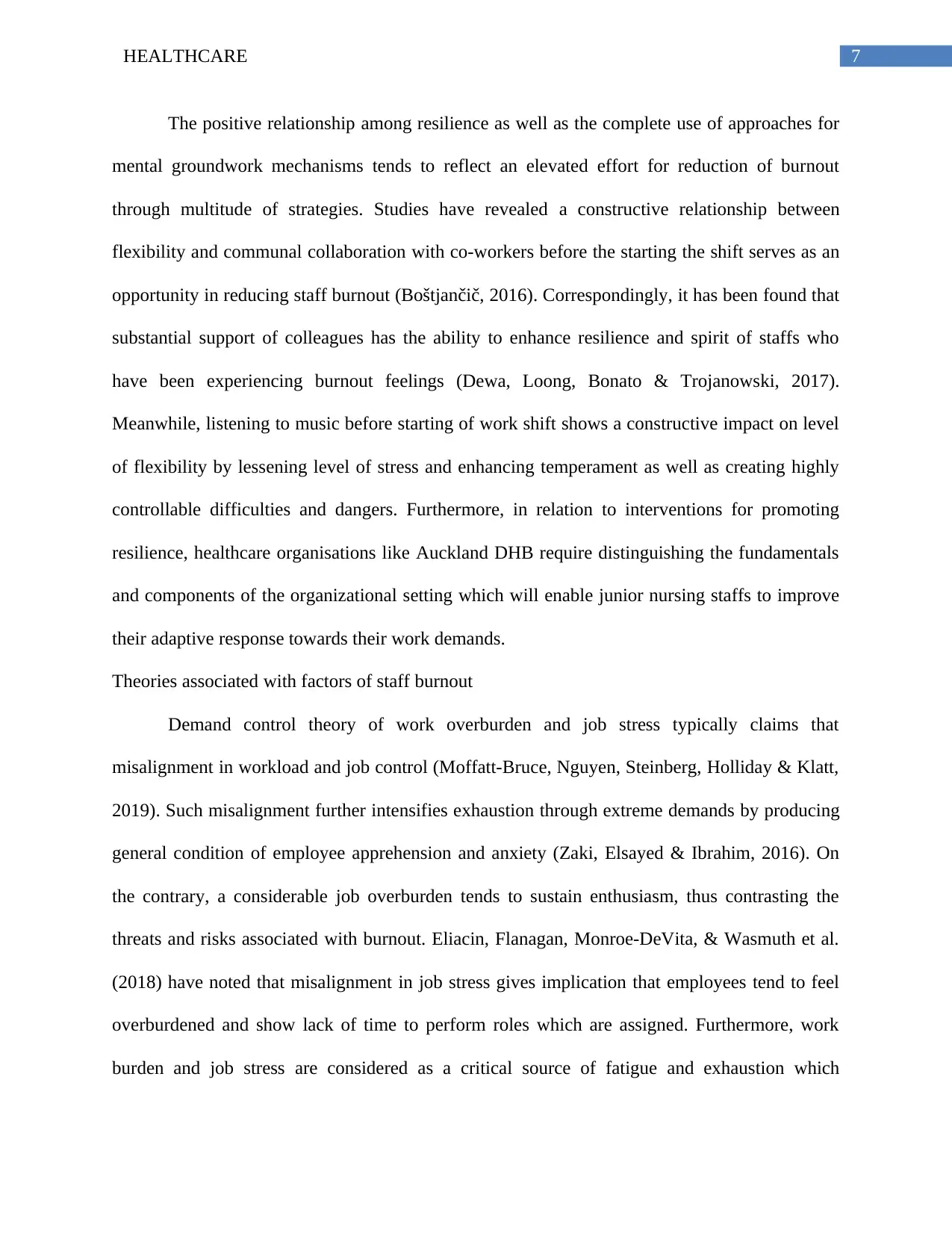
7HEALTHCARE
The positive relationship among resilience as well as the complete use of approaches for
mental groundwork mechanisms tends to reflect an elevated effort for reduction of burnout
through multitude of strategies. Studies have revealed a constructive relationship between
flexibility and communal collaboration with co-workers before the starting the shift serves as an
opportunity in reducing staff burnout (Boštjančič, 2016). Correspondingly, it has been found that
substantial support of colleagues has the ability to enhance resilience and spirit of staffs who
have been experiencing burnout feelings (Dewa, Loong, Bonato & Trojanowski, 2017).
Meanwhile, listening to music before starting of work shift shows a constructive impact on level
of flexibility by lessening level of stress and enhancing temperament as well as creating highly
controllable difficulties and dangers. Furthermore, in relation to interventions for promoting
resilience, healthcare organisations like Auckland DHB require distinguishing the fundamentals
and components of the organizational setting which will enable junior nursing staffs to improve
their adaptive response towards their work demands.
Theories associated with factors of staff burnout
Demand control theory of work overburden and job stress typically claims that
misalignment in workload and job control (Moffatt-Bruce, Nguyen, Steinberg, Holliday & Klatt,
2019). Such misalignment further intensifies exhaustion through extreme demands by producing
general condition of employee apprehension and anxiety (Zaki, Elsayed & Ibrahim, 2016). On
the contrary, a considerable job overburden tends to sustain enthusiasm, thus contrasting the
threats and risks associated with burnout. Eliacin, Flanagan, Monroe-DeVita, & Wasmuth et al.
(2018) have noted that misalignment in job stress gives implication that employees tend to feel
overburdened and show lack of time to perform roles which are assigned. Furthermore, work
burden and job stress are considered as a critical source of fatigue and exhaustion which
The positive relationship among resilience as well as the complete use of approaches for
mental groundwork mechanisms tends to reflect an elevated effort for reduction of burnout
through multitude of strategies. Studies have revealed a constructive relationship between
flexibility and communal collaboration with co-workers before the starting the shift serves as an
opportunity in reducing staff burnout (Boštjančič, 2016). Correspondingly, it has been found that
substantial support of colleagues has the ability to enhance resilience and spirit of staffs who
have been experiencing burnout feelings (Dewa, Loong, Bonato & Trojanowski, 2017).
Meanwhile, listening to music before starting of work shift shows a constructive impact on level
of flexibility by lessening level of stress and enhancing temperament as well as creating highly
controllable difficulties and dangers. Furthermore, in relation to interventions for promoting
resilience, healthcare organisations like Auckland DHB require distinguishing the fundamentals
and components of the organizational setting which will enable junior nursing staffs to improve
their adaptive response towards their work demands.
Theories associated with factors of staff burnout
Demand control theory of work overburden and job stress typically claims that
misalignment in workload and job control (Moffatt-Bruce, Nguyen, Steinberg, Holliday & Klatt,
2019). Such misalignment further intensifies exhaustion through extreme demands by producing
general condition of employee apprehension and anxiety (Zaki, Elsayed & Ibrahim, 2016). On
the contrary, a considerable job overburden tends to sustain enthusiasm, thus contrasting the
threats and risks associated with burnout. Eliacin, Flanagan, Monroe-DeVita, & Wasmuth et al.
(2018) have noted that misalignment in job stress gives implication that employees tend to feel
overburdened and show lack of time to perform roles which are assigned. Furthermore, work
burden and job stress are considered as a critical source of fatigue and exhaustion which
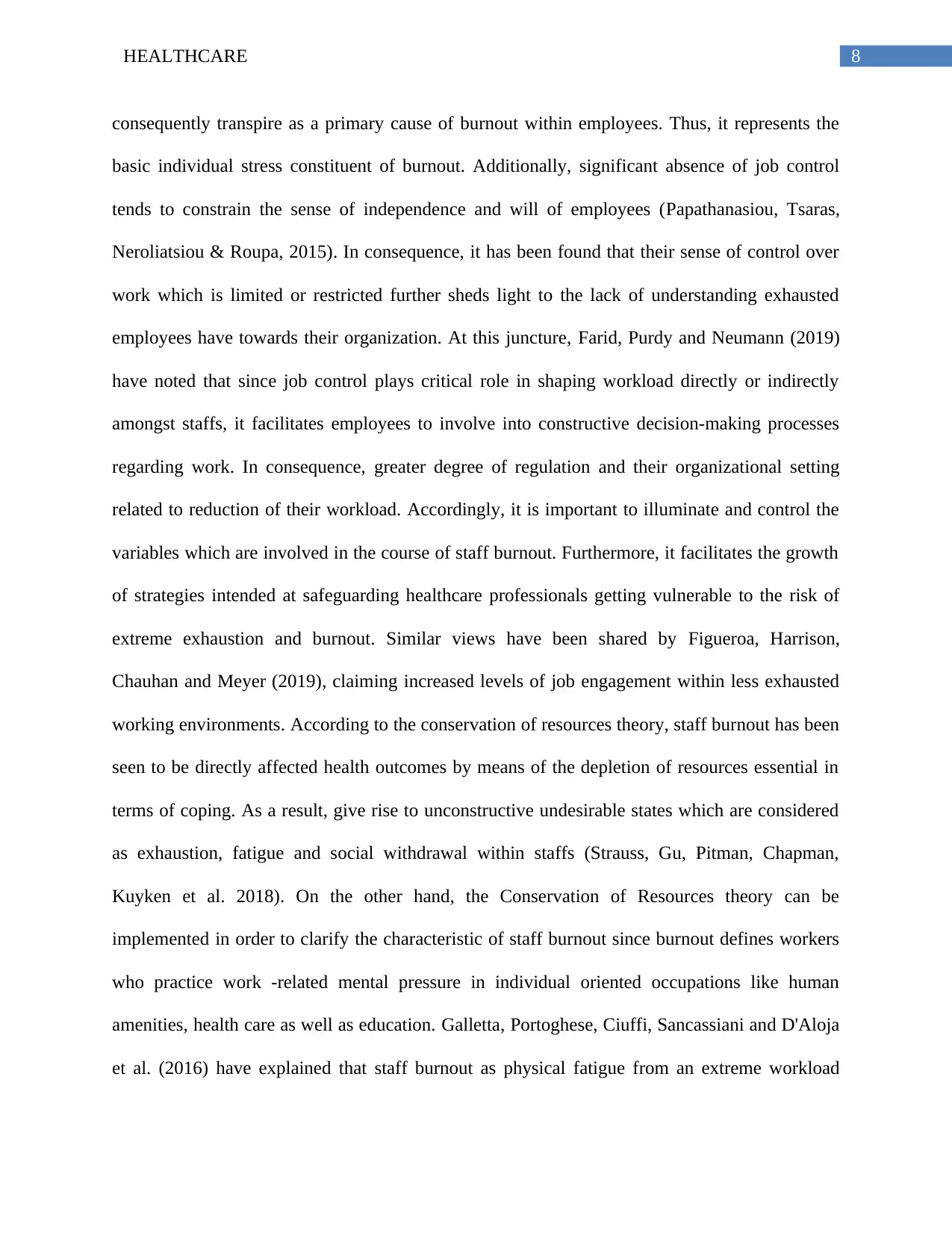
8HEALTHCARE
consequently transpire as a primary cause of burnout within employees. Thus, it represents the
basic individual stress constituent of burnout. Additionally, significant absence of job control
tends to constrain the sense of independence and will of employees (Papathanasiou, Tsaras,
Neroliatsiou & Roupa, 2015). In consequence, it has been found that their sense of control over
work which is limited or restricted further sheds light to the lack of understanding exhausted
employees have towards their organization. At this juncture, Farid, Purdy and Neumann (2019)
have noted that since job control plays critical role in shaping workload directly or indirectly
amongst staffs, it facilitates employees to involve into constructive decision-making processes
regarding work. In consequence, greater degree of regulation and their organizational setting
related to reduction of their workload. Accordingly, it is important to illuminate and control the
variables which are involved in the course of staff burnout. Furthermore, it facilitates the growth
of strategies intended at safeguarding healthcare professionals getting vulnerable to the risk of
extreme exhaustion and burnout. Similar views have been shared by Figueroa, Harrison,
Chauhan and Meyer (2019), claiming increased levels of job engagement within less exhausted
working environments. According to the conservation of resources theory, staff burnout has been
seen to be directly affected health outcomes by means of the depletion of resources essential in
terms of coping. As a result, give rise to unconstructive undesirable states which are considered
as exhaustion, fatigue and social withdrawal within staffs (Strauss, Gu, Pitman, Chapman,
Kuyken et al. 2018). On the other hand, the Conservation of Resources theory can be
implemented in order to clarify the characteristic of staff burnout since burnout defines workers
who practice work -related mental pressure in individual oriented occupations like human
amenities, health care as well as education. Galletta, Portoghese, Ciuffi, Sancassiani and D'Aloja
et al. (2016) have explained that staff burnout as physical fatigue from an extreme workload
consequently transpire as a primary cause of burnout within employees. Thus, it represents the
basic individual stress constituent of burnout. Additionally, significant absence of job control
tends to constrain the sense of independence and will of employees (Papathanasiou, Tsaras,
Neroliatsiou & Roupa, 2015). In consequence, it has been found that their sense of control over
work which is limited or restricted further sheds light to the lack of understanding exhausted
employees have towards their organization. At this juncture, Farid, Purdy and Neumann (2019)
have noted that since job control plays critical role in shaping workload directly or indirectly
amongst staffs, it facilitates employees to involve into constructive decision-making processes
regarding work. In consequence, greater degree of regulation and their organizational setting
related to reduction of their workload. Accordingly, it is important to illuminate and control the
variables which are involved in the course of staff burnout. Furthermore, it facilitates the growth
of strategies intended at safeguarding healthcare professionals getting vulnerable to the risk of
extreme exhaustion and burnout. Similar views have been shared by Figueroa, Harrison,
Chauhan and Meyer (2019), claiming increased levels of job engagement within less exhausted
working environments. According to the conservation of resources theory, staff burnout has been
seen to be directly affected health outcomes by means of the depletion of resources essential in
terms of coping. As a result, give rise to unconstructive undesirable states which are considered
as exhaustion, fatigue and social withdrawal within staffs (Strauss, Gu, Pitman, Chapman,
Kuyken et al. 2018). On the other hand, the Conservation of Resources theory can be
implemented in order to clarify the characteristic of staff burnout since burnout defines workers
who practice work -related mental pressure in individual oriented occupations like human
amenities, health care as well as education. Galletta, Portoghese, Ciuffi, Sancassiani and D'Aloja
et al. (2016) have explained that staff burnout as physical fatigue from an extreme workload
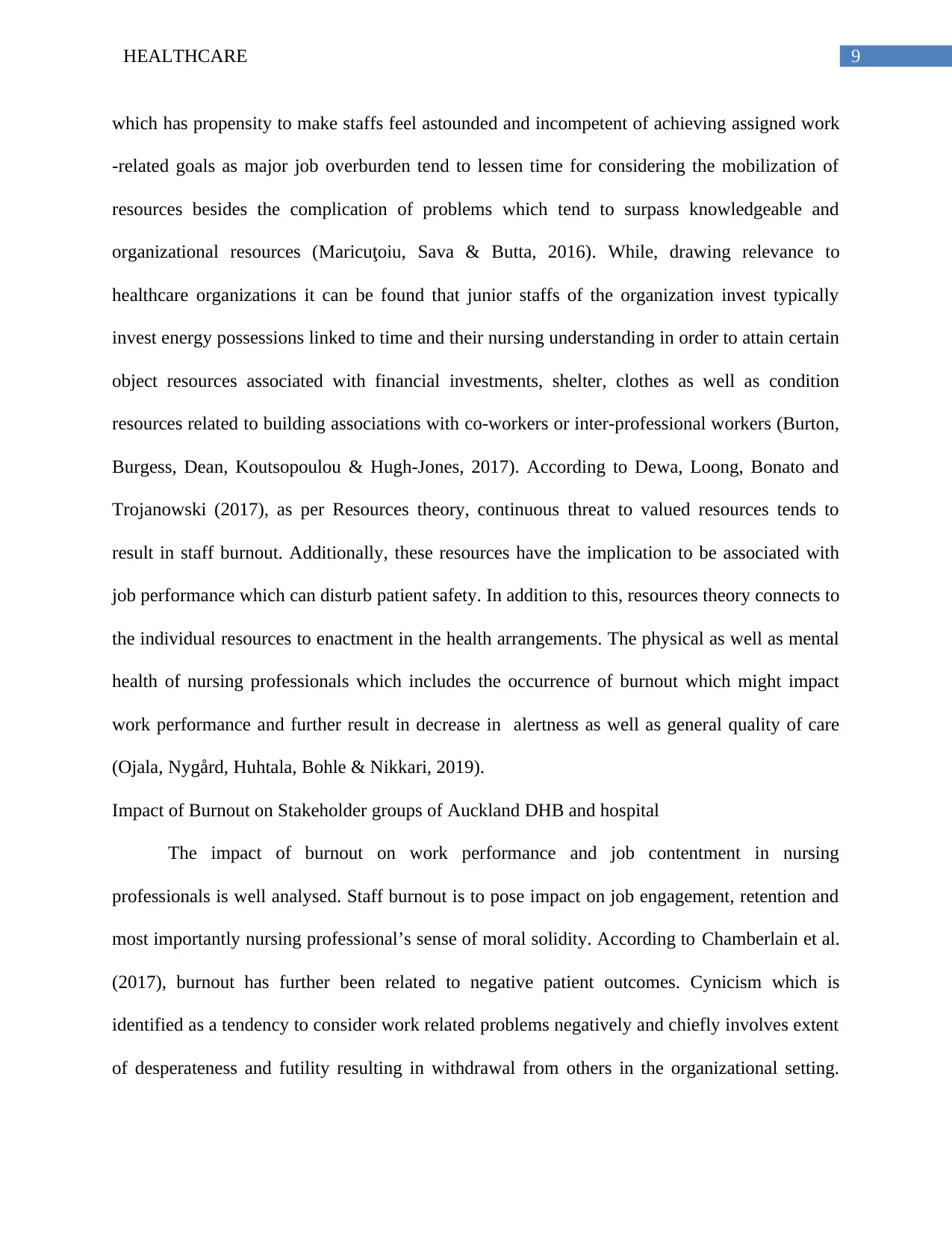
9HEALTHCARE
which has propensity to make staffs feel astounded and incompetent of achieving assigned work
-related goals as major job overburden tend to lessen time for considering the mobilization of
resources besides the complication of problems which tend to surpass knowledgeable and
organizational resources (Maricuţoiu, Sava & Butta, 2016). While, drawing relevance to
healthcare organizations it can be found that junior staffs of the organization invest typically
invest energy possessions linked to time and their nursing understanding in order to attain certain
object resources associated with financial investments, shelter, clothes as well as condition
resources related to building associations with co-workers or inter-professional workers (Burton,
Burgess, Dean, Koutsopoulou & Hugh‐Jones, 2017). According to Dewa, Loong, Bonato and
Trojanowski (2017), as per Resources theory, continuous threat to valued resources tends to
result in staff burnout. Additionally, these resources have the implication to be associated with
job performance which can disturb patient safety. In addition to this, resources theory connects to
the individual resources to enactment in the health arrangements. The physical as well as mental
health of nursing professionals which includes the occurrence of burnout which might impact
work performance and further result in decrease in alertness as well as general quality of care
(Ojala, Nygård, Huhtala, Bohle & Nikkari, 2019).
Impact of Burnout on Stakeholder groups of Auckland DHB and hospital
The impact of burnout on work performance and job contentment in nursing
professionals is well analysed. Staff burnout is to pose impact on job engagement, retention and
most importantly nursing professional’s sense of moral solidity. According to Chamberlain et al.
(2017), burnout has further been related to negative patient outcomes. Cynicism which is
identified as a tendency to consider work related problems negatively and chiefly involves extent
of desperateness and futility resulting in withdrawal from others in the organizational setting.
which has propensity to make staffs feel astounded and incompetent of achieving assigned work
-related goals as major job overburden tend to lessen time for considering the mobilization of
resources besides the complication of problems which tend to surpass knowledgeable and
organizational resources (Maricuţoiu, Sava & Butta, 2016). While, drawing relevance to
healthcare organizations it can be found that junior staffs of the organization invest typically
invest energy possessions linked to time and their nursing understanding in order to attain certain
object resources associated with financial investments, shelter, clothes as well as condition
resources related to building associations with co-workers or inter-professional workers (Burton,
Burgess, Dean, Koutsopoulou & Hugh‐Jones, 2017). According to Dewa, Loong, Bonato and
Trojanowski (2017), as per Resources theory, continuous threat to valued resources tends to
result in staff burnout. Additionally, these resources have the implication to be associated with
job performance which can disturb patient safety. In addition to this, resources theory connects to
the individual resources to enactment in the health arrangements. The physical as well as mental
health of nursing professionals which includes the occurrence of burnout which might impact
work performance and further result in decrease in alertness as well as general quality of care
(Ojala, Nygård, Huhtala, Bohle & Nikkari, 2019).
Impact of Burnout on Stakeholder groups of Auckland DHB and hospital
The impact of burnout on work performance and job contentment in nursing
professionals is well analysed. Staff burnout is to pose impact on job engagement, retention and
most importantly nursing professional’s sense of moral solidity. According to Chamberlain et al.
(2017), burnout has further been related to negative patient outcomes. Cynicism which is
identified as a tendency to consider work related problems negatively and chiefly involves extent
of desperateness and futility resulting in withdrawal from others in the organizational setting.
Secure Best Marks with AI Grader
Need help grading? Try our AI Grader for instant feedback on your assignments.
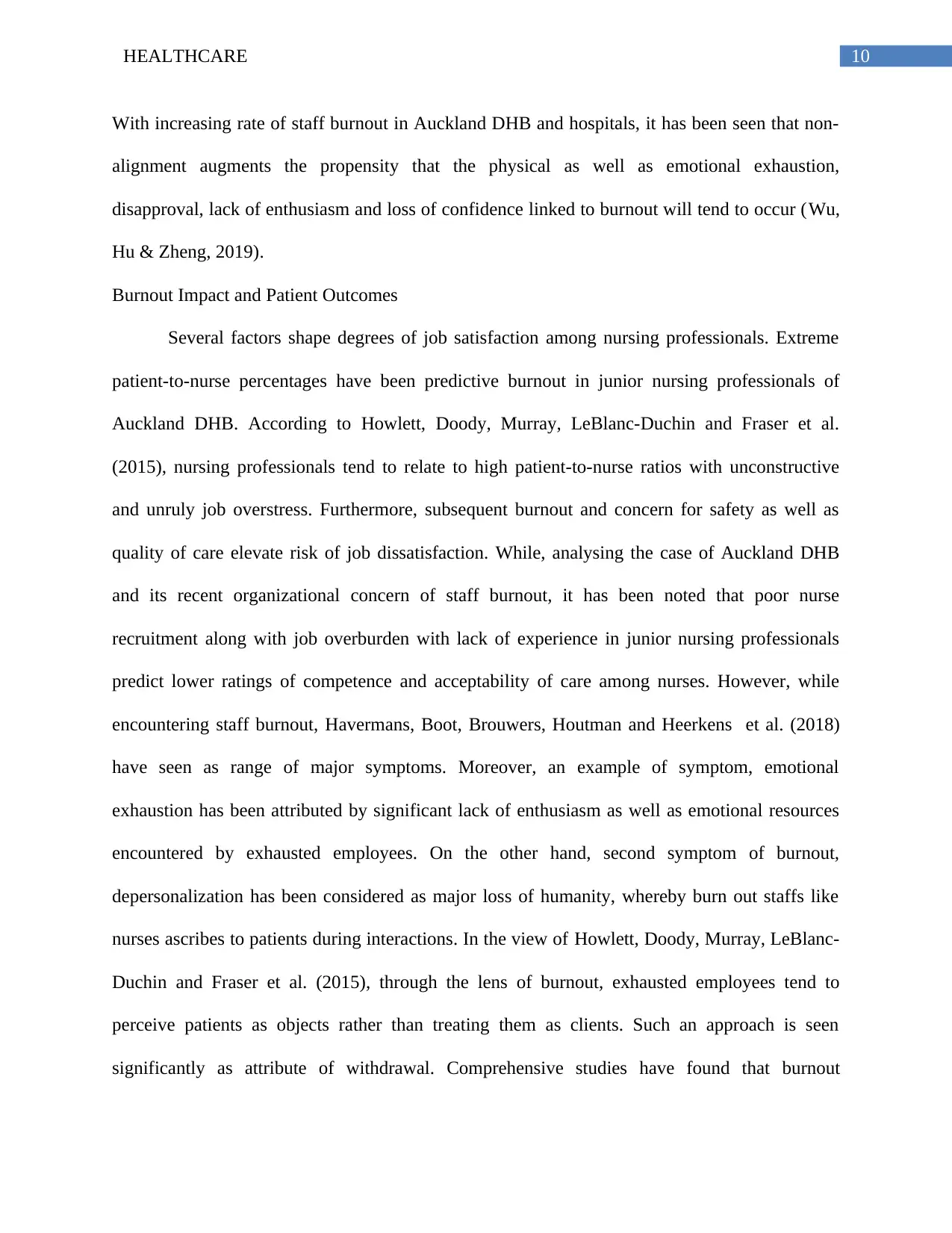
10HEALTHCARE
With increasing rate of staff burnout in Auckland DHB and hospitals, it has been seen that non-
alignment augments the propensity that the physical as well as emotional exhaustion,
disapproval, lack of enthusiasm and loss of confidence linked to burnout will tend to occur (Wu,
Hu & Zheng, 2019).
Burnout Impact and Patient Outcomes
Several factors shape degrees of job satisfaction among nursing professionals. Extreme
patient-to-nurse percentages have been predictive burnout in junior nursing professionals of
Auckland DHB. According to Howlett, Doody, Murray, LeBlanc-Duchin and Fraser et al.
(2015), nursing professionals tend to relate to high patient-to-nurse ratios with unconstructive
and unruly job overstress. Furthermore, subsequent burnout and concern for safety as well as
quality of care elevate risk of job dissatisfaction. While, analysing the case of Auckland DHB
and its recent organizational concern of staff burnout, it has been noted that poor nurse
recruitment along with job overburden with lack of experience in junior nursing professionals
predict lower ratings of competence and acceptability of care among nurses. However, while
encountering staff burnout, Havermans, Boot, Brouwers, Houtman and Heerkens et al. (2018)
have seen as range of major symptoms. Moreover, an example of symptom, emotional
exhaustion has been attributed by significant lack of enthusiasm as well as emotional resources
encountered by exhausted employees. On the other hand, second symptom of burnout,
depersonalization has been considered as major loss of humanity, whereby burn out staffs like
nurses ascribes to patients during interactions. In the view of Howlett, Doody, Murray, LeBlanc-
Duchin and Fraser et al. (2015), through the lens of burnout, exhausted employees tend to
perceive patients as objects rather than treating them as clients. Such an approach is seen
significantly as attribute of withdrawal. Comprehensive studies have found that burnout
With increasing rate of staff burnout in Auckland DHB and hospitals, it has been seen that non-
alignment augments the propensity that the physical as well as emotional exhaustion,
disapproval, lack of enthusiasm and loss of confidence linked to burnout will tend to occur (Wu,
Hu & Zheng, 2019).
Burnout Impact and Patient Outcomes
Several factors shape degrees of job satisfaction among nursing professionals. Extreme
patient-to-nurse percentages have been predictive burnout in junior nursing professionals of
Auckland DHB. According to Howlett, Doody, Murray, LeBlanc-Duchin and Fraser et al.
(2015), nursing professionals tend to relate to high patient-to-nurse ratios with unconstructive
and unruly job overstress. Furthermore, subsequent burnout and concern for safety as well as
quality of care elevate risk of job dissatisfaction. While, analysing the case of Auckland DHB
and its recent organizational concern of staff burnout, it has been noted that poor nurse
recruitment along with job overburden with lack of experience in junior nursing professionals
predict lower ratings of competence and acceptability of care among nurses. However, while
encountering staff burnout, Havermans, Boot, Brouwers, Houtman and Heerkens et al. (2018)
have seen as range of major symptoms. Moreover, an example of symptom, emotional
exhaustion has been attributed by significant lack of enthusiasm as well as emotional resources
encountered by exhausted employees. On the other hand, second symptom of burnout,
depersonalization has been considered as major loss of humanity, whereby burn out staffs like
nurses ascribes to patients during interactions. In the view of Howlett, Doody, Murray, LeBlanc-
Duchin and Fraser et al. (2015), through the lens of burnout, exhausted employees tend to
perceive patients as objects rather than treating them as clients. Such an approach is seen
significantly as attribute of withdrawal. Comprehensive studies have found that burnout
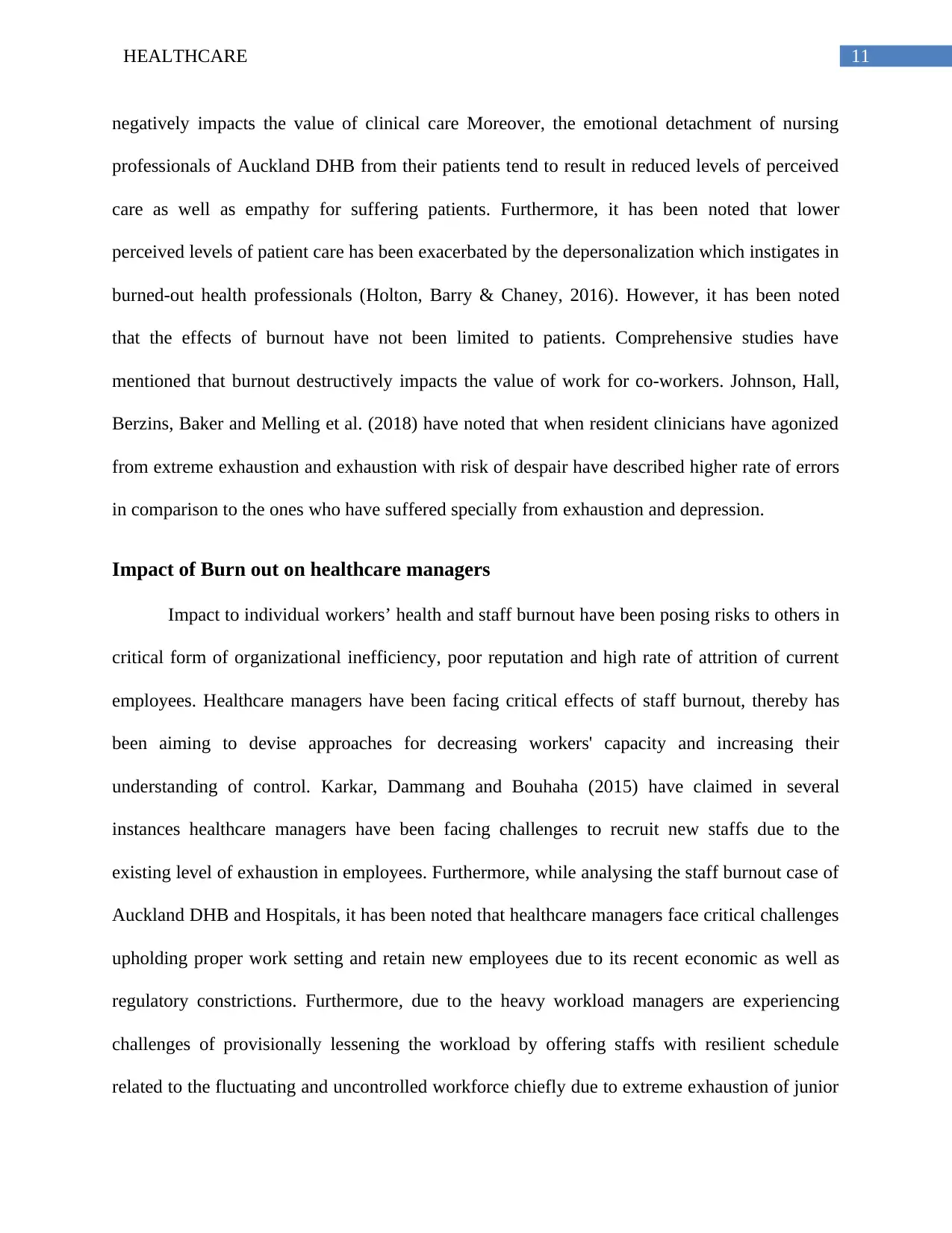
11HEALTHCARE
negatively impacts the value of clinical care Moreover, the emotional detachment of nursing
professionals of Auckland DHB from their patients tend to result in reduced levels of perceived
care as well as empathy for suffering patients. Furthermore, it has been noted that lower
perceived levels of patient care has been exacerbated by the depersonalization which instigates in
burned-out health professionals (Holton, Barry & Chaney, 2016). However, it has been noted
that the effects of burnout have not been limited to patients. Comprehensive studies have
mentioned that burnout destructively impacts the value of work for co-workers. Johnson, Hall,
Berzins, Baker and Melling et al. (2018) have noted that when resident clinicians have agonized
from extreme exhaustion and exhaustion with risk of despair have described higher rate of errors
in comparison to the ones who have suffered specially from exhaustion and depression.
Impact of Burn out on healthcare managers
Impact to individual workers’ health and staff burnout have been posing risks to others in
critical form of organizational inefficiency, poor reputation and high rate of attrition of current
employees. Healthcare managers have been facing critical effects of staff burnout, thereby has
been aiming to devise approaches for decreasing workers' capacity and increasing their
understanding of control. Karkar, Dammang and Bouhaha (2015) have claimed in several
instances healthcare managers have been facing challenges to recruit new staffs due to the
existing level of exhaustion in employees. Furthermore, while analysing the staff burnout case of
Auckland DHB and Hospitals, it has been noted that healthcare managers face critical challenges
upholding proper work setting and retain new employees due to its recent economic as well as
regulatory constrictions. Furthermore, due to the heavy workload managers are experiencing
challenges of provisionally lessening the workload by offering staffs with resilient schedule
related to the fluctuating and uncontrolled workforce chiefly due to extreme exhaustion of junior
negatively impacts the value of clinical care Moreover, the emotional detachment of nursing
professionals of Auckland DHB from their patients tend to result in reduced levels of perceived
care as well as empathy for suffering patients. Furthermore, it has been noted that lower
perceived levels of patient care has been exacerbated by the depersonalization which instigates in
burned-out health professionals (Holton, Barry & Chaney, 2016). However, it has been noted
that the effects of burnout have not been limited to patients. Comprehensive studies have
mentioned that burnout destructively impacts the value of work for co-workers. Johnson, Hall,
Berzins, Baker and Melling et al. (2018) have noted that when resident clinicians have agonized
from extreme exhaustion and exhaustion with risk of despair have described higher rate of errors
in comparison to the ones who have suffered specially from exhaustion and depression.
Impact of Burn out on healthcare managers
Impact to individual workers’ health and staff burnout have been posing risks to others in
critical form of organizational inefficiency, poor reputation and high rate of attrition of current
employees. Healthcare managers have been facing critical effects of staff burnout, thereby has
been aiming to devise approaches for decreasing workers' capacity and increasing their
understanding of control. Karkar, Dammang and Bouhaha (2015) have claimed in several
instances healthcare managers have been facing challenges to recruit new staffs due to the
existing level of exhaustion in employees. Furthermore, while analysing the staff burnout case of
Auckland DHB and Hospitals, it has been noted that healthcare managers face critical challenges
upholding proper work setting and retain new employees due to its recent economic as well as
regulatory constrictions. Furthermore, due to the heavy workload managers are experiencing
challenges of provisionally lessening the workload by offering staffs with resilient schedule
related to the fluctuating and uncontrolled workforce chiefly due to extreme exhaustion of junior
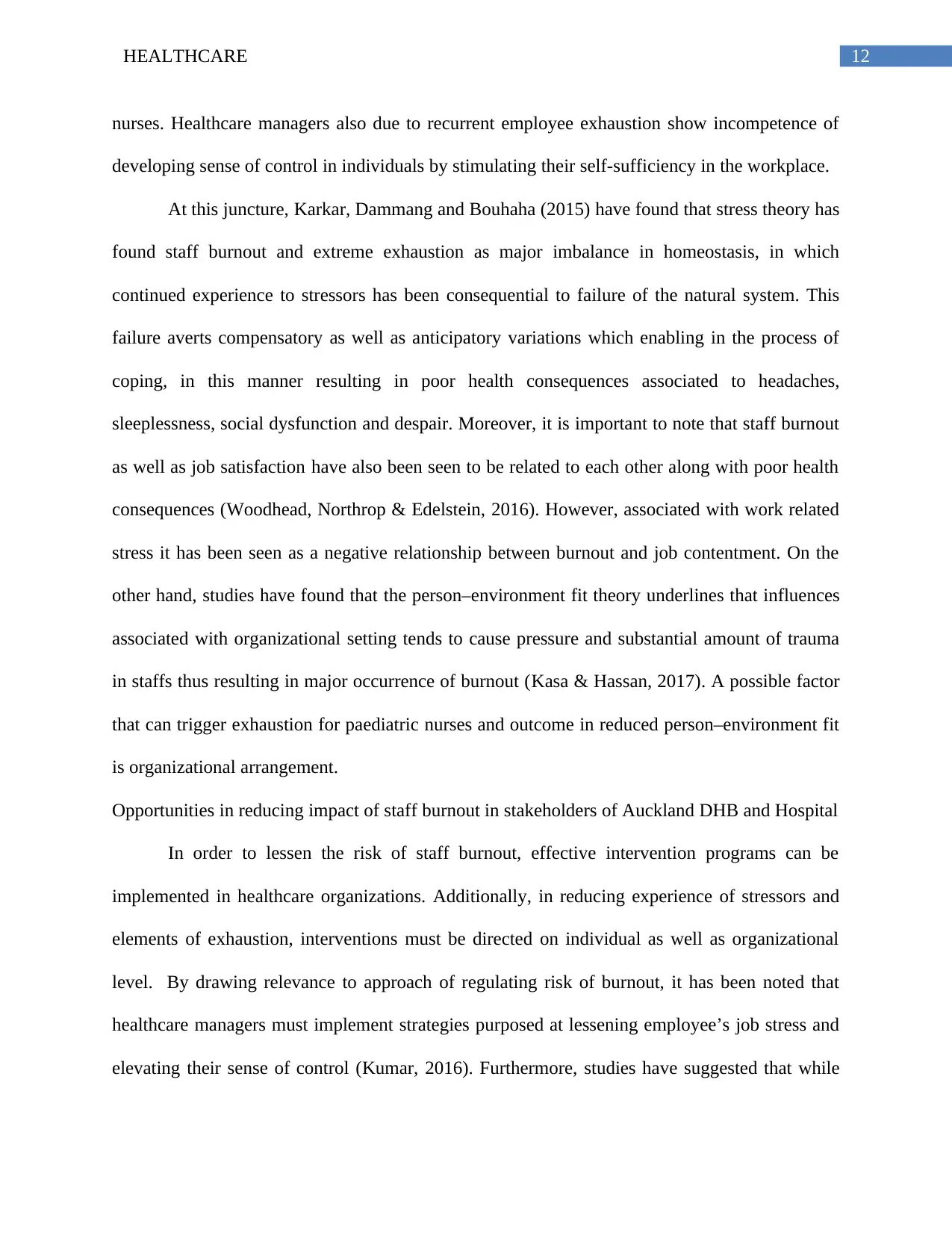
12HEALTHCARE
nurses. Healthcare managers also due to recurrent employee exhaustion show incompetence of
developing sense of control in individuals by stimulating their self-sufficiency in the workplace.
At this juncture, Karkar, Dammang and Bouhaha (2015) have found that stress theory has
found staff burnout and extreme exhaustion as major imbalance in homeostasis, in which
continued experience to stressors has been consequential to failure of the natural system. This
failure averts compensatory as well as anticipatory variations which enabling in the process of
coping, in this manner resulting in poor health consequences associated to headaches,
sleeplessness, social dysfunction and despair. Moreover, it is important to note that staff burnout
as well as job satisfaction have also been seen to be related to each other along with poor health
consequences (Woodhead, Northrop & Edelstein, 2016). However, associated with work related
stress it has been seen as a negative relationship between burnout and job contentment. On the
other hand, studies have found that the person–environment fit theory underlines that influences
associated with organizational setting tends to cause pressure and substantial amount of trauma
in staffs thus resulting in major occurrence of burnout (Kasa & Hassan, 2017). A possible factor
that can trigger exhaustion for paediatric nurses and outcome in reduced person–environment fit
is organizational arrangement.
Opportunities in reducing impact of staff burnout in stakeholders of Auckland DHB and Hospital
In order to lessen the risk of staff burnout, effective intervention programs can be
implemented in healthcare organizations. Additionally, in reducing experience of stressors and
elements of exhaustion, interventions must be directed on individual as well as organizational
level. By drawing relevance to approach of regulating risk of burnout, it has been noted that
healthcare managers must implement strategies purposed at lessening employee’s job stress and
elevating their sense of control (Kumar, 2016). Furthermore, studies have suggested that while
nurses. Healthcare managers also due to recurrent employee exhaustion show incompetence of
developing sense of control in individuals by stimulating their self-sufficiency in the workplace.
At this juncture, Karkar, Dammang and Bouhaha (2015) have found that stress theory has
found staff burnout and extreme exhaustion as major imbalance in homeostasis, in which
continued experience to stressors has been consequential to failure of the natural system. This
failure averts compensatory as well as anticipatory variations which enabling in the process of
coping, in this manner resulting in poor health consequences associated to headaches,
sleeplessness, social dysfunction and despair. Moreover, it is important to note that staff burnout
as well as job satisfaction have also been seen to be related to each other along with poor health
consequences (Woodhead, Northrop & Edelstein, 2016). However, associated with work related
stress it has been seen as a negative relationship between burnout and job contentment. On the
other hand, studies have found that the person–environment fit theory underlines that influences
associated with organizational setting tends to cause pressure and substantial amount of trauma
in staffs thus resulting in major occurrence of burnout (Kasa & Hassan, 2017). A possible factor
that can trigger exhaustion for paediatric nurses and outcome in reduced person–environment fit
is organizational arrangement.
Opportunities in reducing impact of staff burnout in stakeholders of Auckland DHB and Hospital
In order to lessen the risk of staff burnout, effective intervention programs can be
implemented in healthcare organizations. Additionally, in reducing experience of stressors and
elements of exhaustion, interventions must be directed on individual as well as organizational
level. By drawing relevance to approach of regulating risk of burnout, it has been noted that
healthcare managers must implement strategies purposed at lessening employee’s job stress and
elevating their sense of control (Kumar, 2016). Furthermore, studies have suggested that while
Paraphrase This Document
Need a fresh take? Get an instant paraphrase of this document with our AI Paraphraser
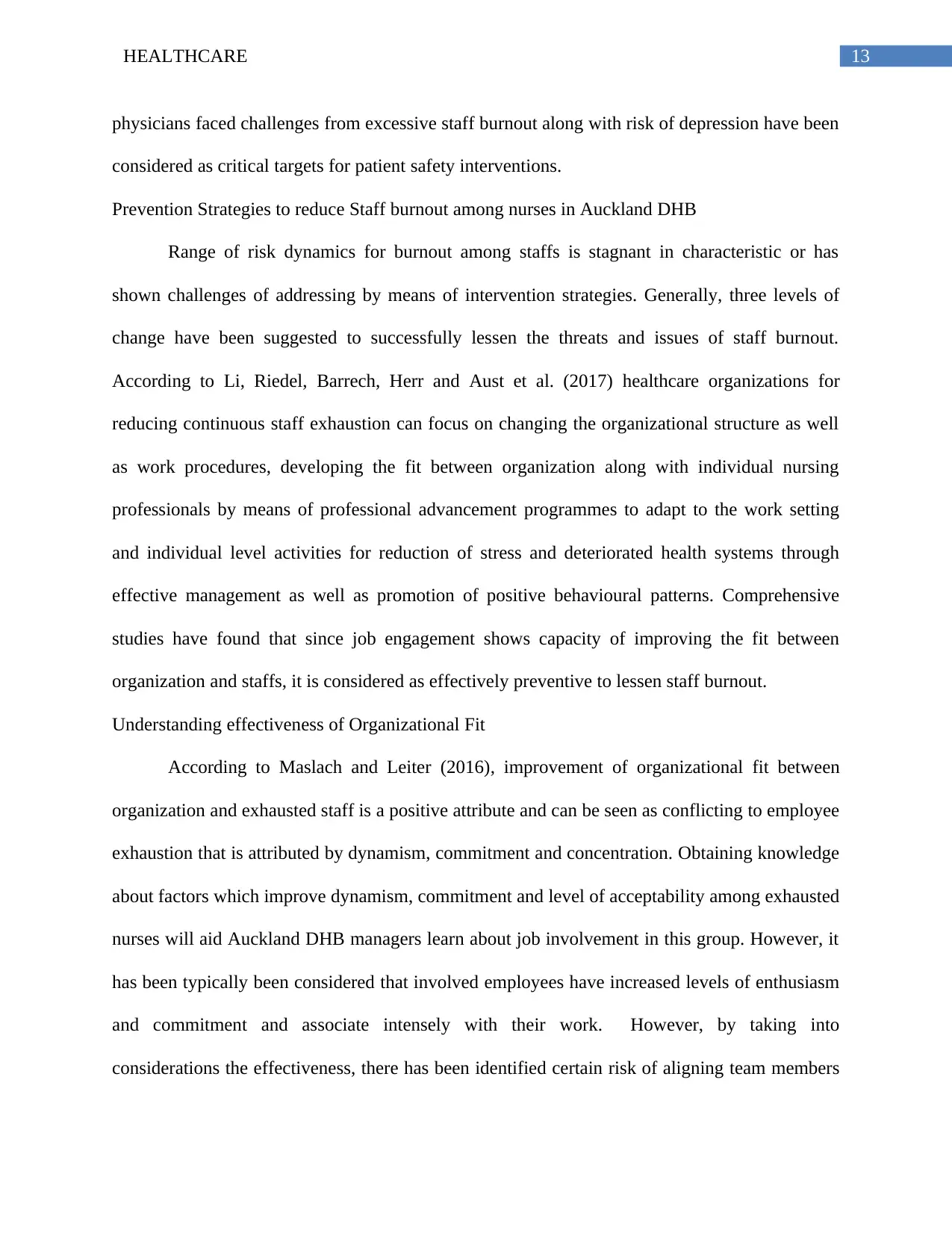
13HEALTHCARE
physicians faced challenges from excessive staff burnout along with risk of depression have been
considered as critical targets for patient safety interventions.
Prevention Strategies to reduce Staff burnout among nurses in Auckland DHB
Range of risk dynamics for burnout among staffs is stagnant in characteristic or has
shown challenges of addressing by means of intervention strategies. Generally, three levels of
change have been suggested to successfully lessen the threats and issues of staff burnout.
According to Li, Riedel, Barrech, Herr and Aust et al. (2017) healthcare organizations for
reducing continuous staff exhaustion can focus on changing the organizational structure as well
as work procedures, developing the fit between organization along with individual nursing
professionals by means of professional advancement programmes to adapt to the work setting
and individual level activities for reduction of stress and deteriorated health systems through
effective management as well as promotion of positive behavioural patterns. Comprehensive
studies have found that since job engagement shows capacity of improving the fit between
organization and staffs, it is considered as effectively preventive to lessen staff burnout.
Understanding effectiveness of Organizational Fit
According to Maslach and Leiter (2016), improvement of organizational fit between
organization and exhausted staff is a positive attribute and can be seen as conflicting to employee
exhaustion that is attributed by dynamism, commitment and concentration. Obtaining knowledge
about factors which improve dynamism, commitment and level of acceptability among exhausted
nurses will aid Auckland DHB managers learn about job involvement in this group. However, it
has been typically been considered that involved employees have increased levels of enthusiasm
and commitment and associate intensely with their work. However, by taking into
considerations the effectiveness, there has been identified certain risk of aligning team members
physicians faced challenges from excessive staff burnout along with risk of depression have been
considered as critical targets for patient safety interventions.
Prevention Strategies to reduce Staff burnout among nurses in Auckland DHB
Range of risk dynamics for burnout among staffs is stagnant in characteristic or has
shown challenges of addressing by means of intervention strategies. Generally, three levels of
change have been suggested to successfully lessen the threats and issues of staff burnout.
According to Li, Riedel, Barrech, Herr and Aust et al. (2017) healthcare organizations for
reducing continuous staff exhaustion can focus on changing the organizational structure as well
as work procedures, developing the fit between organization along with individual nursing
professionals by means of professional advancement programmes to adapt to the work setting
and individual level activities for reduction of stress and deteriorated health systems through
effective management as well as promotion of positive behavioural patterns. Comprehensive
studies have found that since job engagement shows capacity of improving the fit between
organization and staffs, it is considered as effectively preventive to lessen staff burnout.
Understanding effectiveness of Organizational Fit
According to Maslach and Leiter (2016), improvement of organizational fit between
organization and exhausted staff is a positive attribute and can be seen as conflicting to employee
exhaustion that is attributed by dynamism, commitment and concentration. Obtaining knowledge
about factors which improve dynamism, commitment and level of acceptability among exhausted
nurses will aid Auckland DHB managers learn about job involvement in this group. However, it
has been typically been considered that involved employees have increased levels of enthusiasm
and commitment and associate intensely with their work. However, by taking into
considerations the effectiveness, there has been identified certain risk of aligning team members
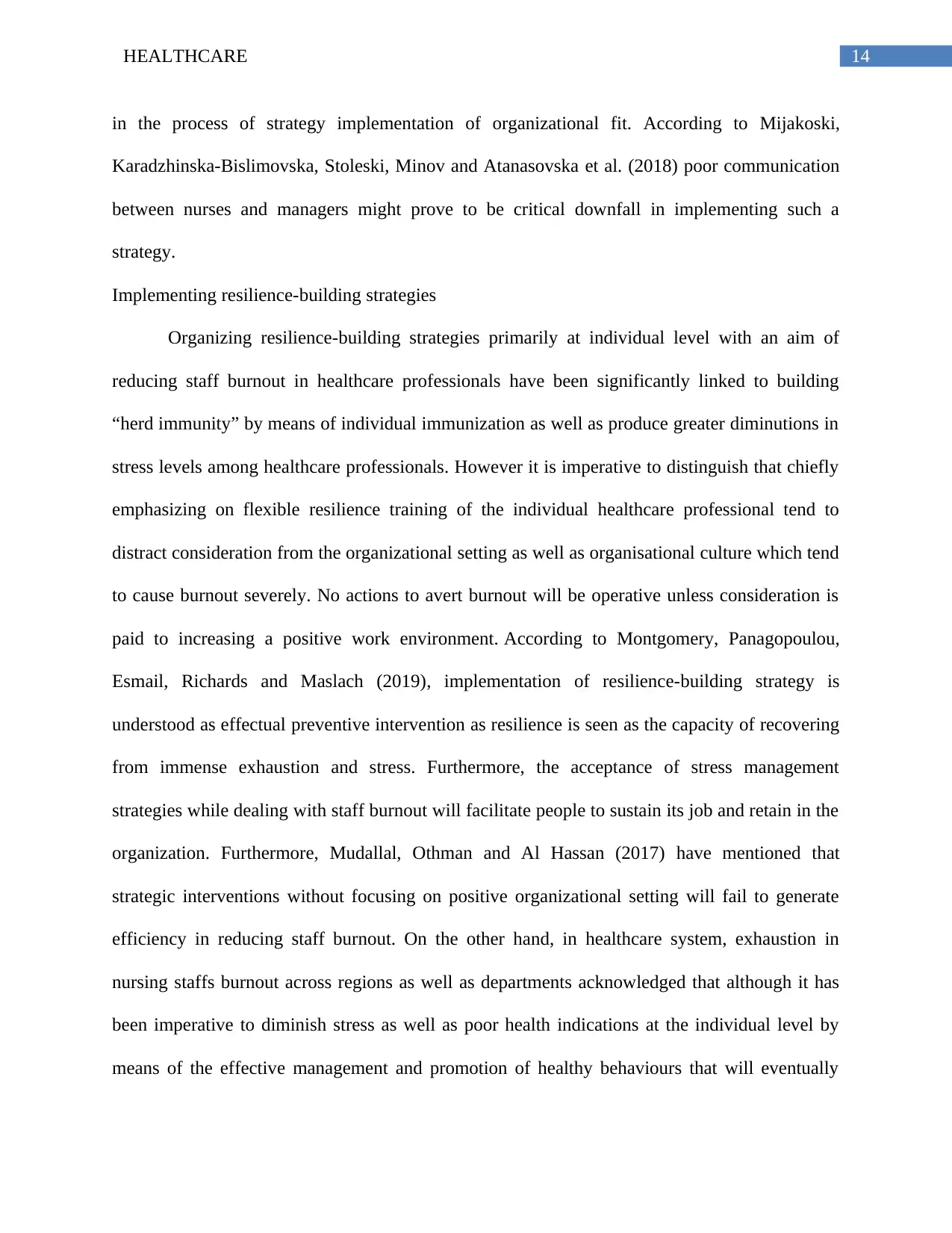
14HEALTHCARE
in the process of strategy implementation of organizational fit. According to Mijakoski,
Karadzhinska-Bislimovska, Stoleski, Minov and Atanasovska et al. (2018) poor communication
between nurses and managers might prove to be critical downfall in implementing such a
strategy.
Implementing resilience-building strategies
Organizing resilience-building strategies primarily at individual level with an aim of
reducing staff burnout in healthcare professionals have been significantly linked to building
“herd immunity” by means of individual immunization as well as produce greater diminutions in
stress levels among healthcare professionals. However it is imperative to distinguish that chiefly
emphasizing on flexible resilience training of the individual healthcare professional tend to
distract consideration from the organizational setting as well as organisational culture which tend
to cause burnout severely. No actions to avert burnout will be operative unless consideration is
paid to increasing a positive work environment. According to Montgomery, Panagopoulou,
Esmail, Richards and Maslach (2019), implementation of resilience-building strategy is
understood as effectual preventive intervention as resilience is seen as the capacity of recovering
from immense exhaustion and stress. Furthermore, the acceptance of stress management
strategies while dealing with staff burnout will facilitate people to sustain its job and retain in the
organization. Furthermore, Mudallal, Othman and Al Hassan (2017) have mentioned that
strategic interventions without focusing on positive organizational setting will fail to generate
efficiency in reducing staff burnout. On the other hand, in healthcare system, exhaustion in
nursing staffs burnout across regions as well as departments acknowledged that although it has
been imperative to diminish stress as well as poor health indications at the individual level by
means of the effective management and promotion of healthy behaviours that will eventually
in the process of strategy implementation of organizational fit. According to Mijakoski,
Karadzhinska-Bislimovska, Stoleski, Minov and Atanasovska et al. (2018) poor communication
between nurses and managers might prove to be critical downfall in implementing such a
strategy.
Implementing resilience-building strategies
Organizing resilience-building strategies primarily at individual level with an aim of
reducing staff burnout in healthcare professionals have been significantly linked to building
“herd immunity” by means of individual immunization as well as produce greater diminutions in
stress levels among healthcare professionals. However it is imperative to distinguish that chiefly
emphasizing on flexible resilience training of the individual healthcare professional tend to
distract consideration from the organizational setting as well as organisational culture which tend
to cause burnout severely. No actions to avert burnout will be operative unless consideration is
paid to increasing a positive work environment. According to Montgomery, Panagopoulou,
Esmail, Richards and Maslach (2019), implementation of resilience-building strategy is
understood as effectual preventive intervention as resilience is seen as the capacity of recovering
from immense exhaustion and stress. Furthermore, the acceptance of stress management
strategies while dealing with staff burnout will facilitate people to sustain its job and retain in the
organization. Furthermore, Mudallal, Othman and Al Hassan (2017) have mentioned that
strategic interventions without focusing on positive organizational setting will fail to generate
efficiency in reducing staff burnout. On the other hand, in healthcare system, exhaustion in
nursing staffs burnout across regions as well as departments acknowledged that although it has
been imperative to diminish stress as well as poor health indications at the individual level by
means of the effective management and promotion of healthy behaviours that will eventually
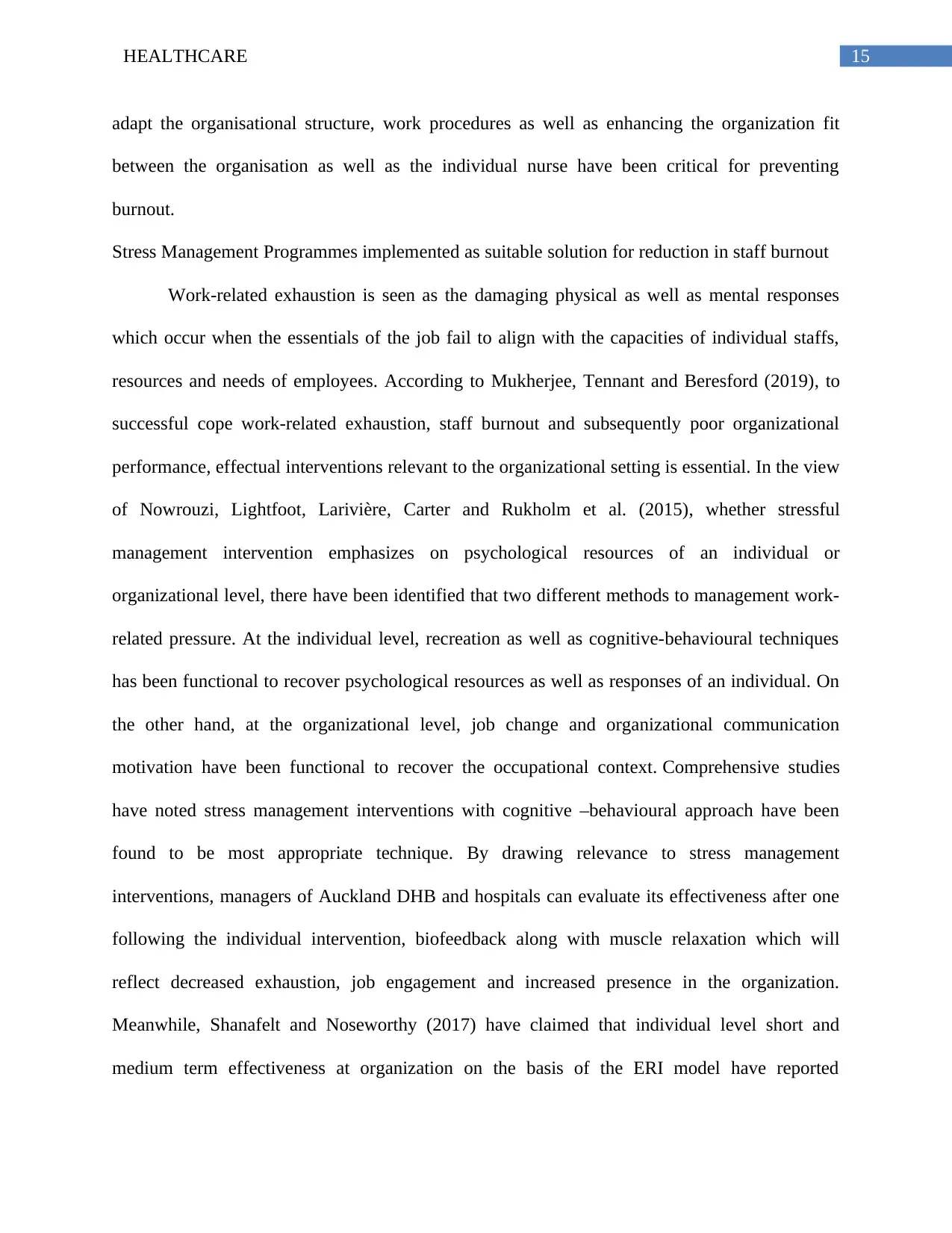
15HEALTHCARE
adapt the organisational structure, work procedures as well as enhancing the organization fit
between the organisation as well as the individual nurse have been critical for preventing
burnout.
Stress Management Programmes implemented as suitable solution for reduction in staff burnout
Work-related exhaustion is seen as the damaging physical as well as mental responses
which occur when the essentials of the job fail to align with the capacities of individual staffs,
resources and needs of employees. According to Mukherjee, Tennant and Beresford (2019), to
successful cope work-related exhaustion, staff burnout and subsequently poor organizational
performance, effectual interventions relevant to the organizational setting is essential. In the view
of Nowrouzi, Lightfoot, Larivière, Carter and Rukholm et al. (2015), whether stressful
management intervention emphasizes on psychological resources of an individual or
organizational level, there have been identified that two different methods to management work-
related pressure. At the individual level, recreation as well as cognitive-behavioural techniques
has been functional to recover psychological resources as well as responses of an individual. On
the other hand, at the organizational level, job change and organizational communication
motivation have been functional to recover the occupational context. Comprehensive studies
have noted stress management interventions with cognitive –behavioural approach have been
found to be most appropriate technique. By drawing relevance to stress management
interventions, managers of Auckland DHB and hospitals can evaluate its effectiveness after one
following the individual intervention, biofeedback along with muscle relaxation which will
reflect decreased exhaustion, job engagement and increased presence in the organization.
Meanwhile, Shanafelt and Noseworthy (2017) have claimed that individual level short and
medium term effectiveness at organization on the basis of the ERI model have reported
adapt the organisational structure, work procedures as well as enhancing the organization fit
between the organisation as well as the individual nurse have been critical for preventing
burnout.
Stress Management Programmes implemented as suitable solution for reduction in staff burnout
Work-related exhaustion is seen as the damaging physical as well as mental responses
which occur when the essentials of the job fail to align with the capacities of individual staffs,
resources and needs of employees. According to Mukherjee, Tennant and Beresford (2019), to
successful cope work-related exhaustion, staff burnout and subsequently poor organizational
performance, effectual interventions relevant to the organizational setting is essential. In the view
of Nowrouzi, Lightfoot, Larivière, Carter and Rukholm et al. (2015), whether stressful
management intervention emphasizes on psychological resources of an individual or
organizational level, there have been identified that two different methods to management work-
related pressure. At the individual level, recreation as well as cognitive-behavioural techniques
has been functional to recover psychological resources as well as responses of an individual. On
the other hand, at the organizational level, job change and organizational communication
motivation have been functional to recover the occupational context. Comprehensive studies
have noted stress management interventions with cognitive –behavioural approach have been
found to be most appropriate technique. By drawing relevance to stress management
interventions, managers of Auckland DHB and hospitals can evaluate its effectiveness after one
following the individual intervention, biofeedback along with muscle relaxation which will
reflect decreased exhaustion, job engagement and increased presence in the organization.
Meanwhile, Shanafelt and Noseworthy (2017) have claimed that individual level short and
medium term effectiveness at organization on the basis of the ERI model have reported
Secure Best Marks with AI Grader
Need help grading? Try our AI Grader for instant feedback on your assignments.
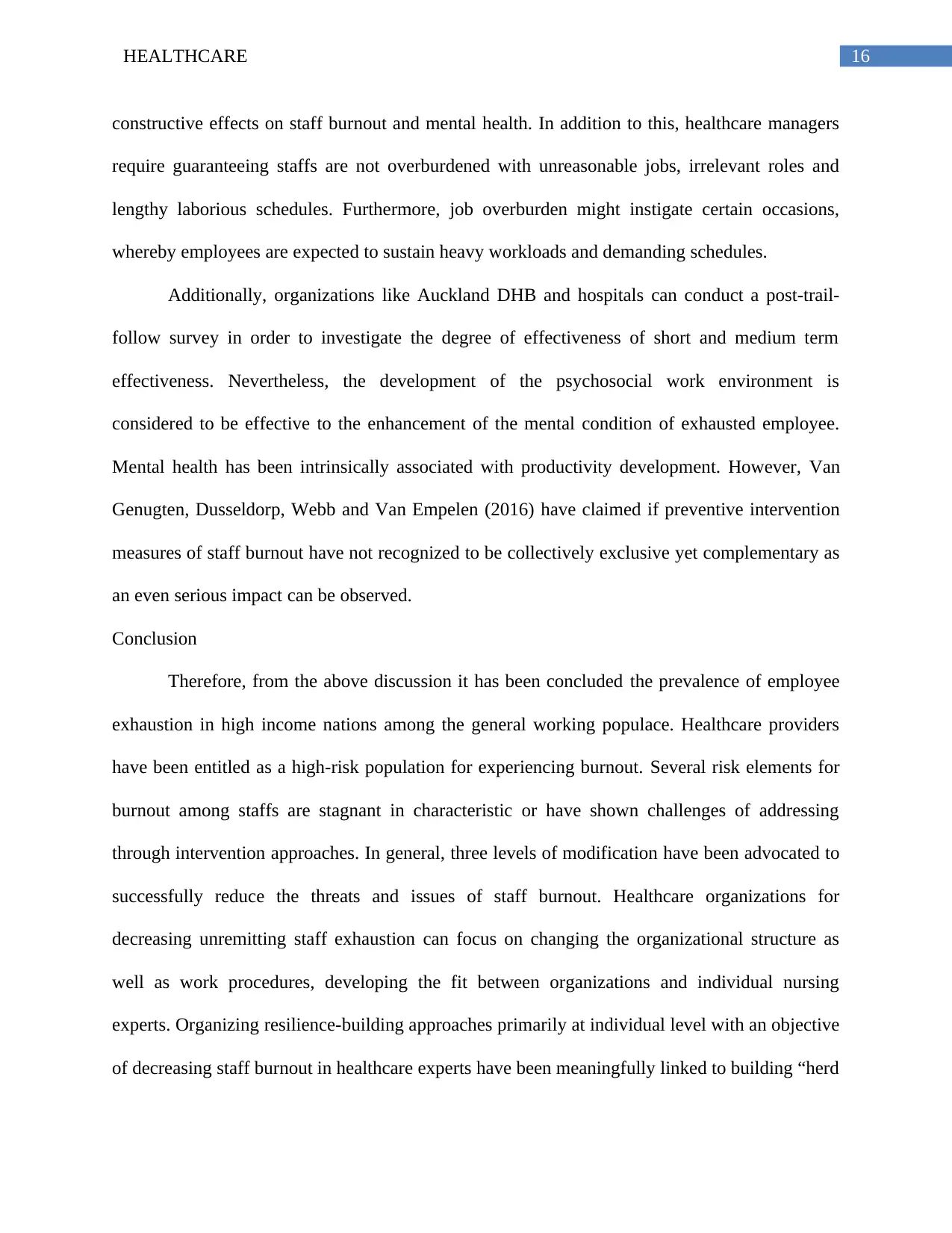
16HEALTHCARE
constructive effects on staff burnout and mental health. In addition to this, healthcare managers
require guaranteeing staffs are not overburdened with unreasonable jobs, irrelevant roles and
lengthy laborious schedules. Furthermore, job overburden might instigate certain occasions,
whereby employees are expected to sustain heavy workloads and demanding schedules.
Additionally, organizations like Auckland DHB and hospitals can conduct a post-trail-
follow survey in order to investigate the degree of effectiveness of short and medium term
effectiveness. Nevertheless, the development of the psychosocial work environment is
considered to be effective to the enhancement of the mental condition of exhausted employee.
Mental health has been intrinsically associated with productivity development. However, Van
Genugten, Dusseldorp, Webb and Van Empelen (2016) have claimed if preventive intervention
measures of staff burnout have not recognized to be collectively exclusive yet complementary as
an even serious impact can be observed.
Conclusion
Therefore, from the above discussion it has been concluded the prevalence of employee
exhaustion in high income nations among the general working populace. Healthcare providers
have been entitled as a high-risk population for experiencing burnout. Several risk elements for
burnout among staffs are stagnant in characteristic or have shown challenges of addressing
through intervention approaches. In general, three levels of modification have been advocated to
successfully reduce the threats and issues of staff burnout. Healthcare organizations for
decreasing unremitting staff exhaustion can focus on changing the organizational structure as
well as work procedures, developing the fit between organizations and individual nursing
experts. Organizing resilience-building approaches primarily at individual level with an objective
of decreasing staff burnout in healthcare experts have been meaningfully linked to building “herd
constructive effects on staff burnout and mental health. In addition to this, healthcare managers
require guaranteeing staffs are not overburdened with unreasonable jobs, irrelevant roles and
lengthy laborious schedules. Furthermore, job overburden might instigate certain occasions,
whereby employees are expected to sustain heavy workloads and demanding schedules.
Additionally, organizations like Auckland DHB and hospitals can conduct a post-trail-
follow survey in order to investigate the degree of effectiveness of short and medium term
effectiveness. Nevertheless, the development of the psychosocial work environment is
considered to be effective to the enhancement of the mental condition of exhausted employee.
Mental health has been intrinsically associated with productivity development. However, Van
Genugten, Dusseldorp, Webb and Van Empelen (2016) have claimed if preventive intervention
measures of staff burnout have not recognized to be collectively exclusive yet complementary as
an even serious impact can be observed.
Conclusion
Therefore, from the above discussion it has been concluded the prevalence of employee
exhaustion in high income nations among the general working populace. Healthcare providers
have been entitled as a high-risk population for experiencing burnout. Several risk elements for
burnout among staffs are stagnant in characteristic or have shown challenges of addressing
through intervention approaches. In general, three levels of modification have been advocated to
successfully reduce the threats and issues of staff burnout. Healthcare organizations for
decreasing unremitting staff exhaustion can focus on changing the organizational structure as
well as work procedures, developing the fit between organizations and individual nursing
experts. Organizing resilience-building approaches primarily at individual level with an objective
of decreasing staff burnout in healthcare experts have been meaningfully linked to building “herd
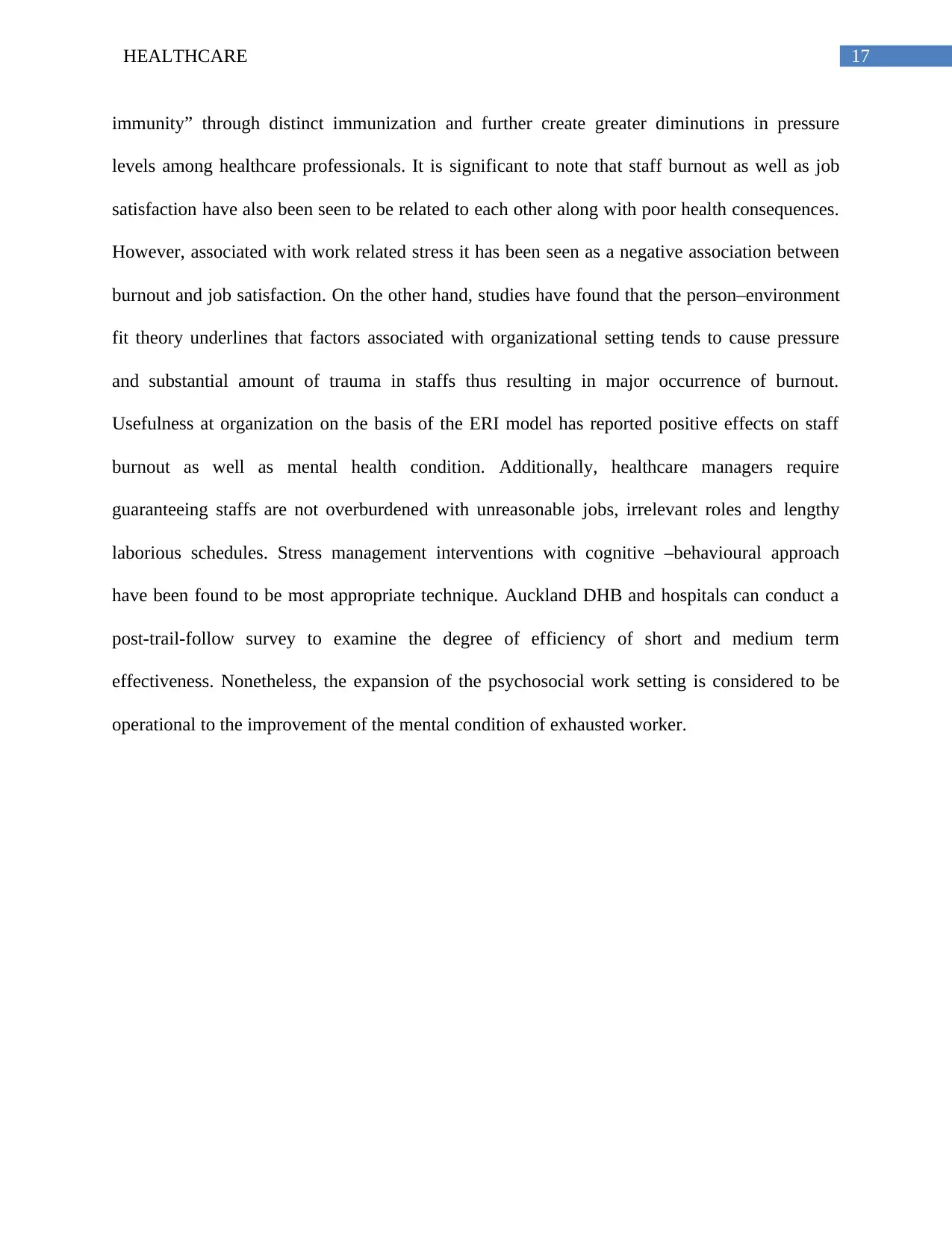
17HEALTHCARE
immunity” through distinct immunization and further create greater diminutions in pressure
levels among healthcare professionals. It is significant to note that staff burnout as well as job
satisfaction have also been seen to be related to each other along with poor health consequences.
However, associated with work related stress it has been seen as a negative association between
burnout and job satisfaction. On the other hand, studies have found that the person–environment
fit theory underlines that factors associated with organizational setting tends to cause pressure
and substantial amount of trauma in staffs thus resulting in major occurrence of burnout.
Usefulness at organization on the basis of the ERI model has reported positive effects on staff
burnout as well as mental health condition. Additionally, healthcare managers require
guaranteeing staffs are not overburdened with unreasonable jobs, irrelevant roles and lengthy
laborious schedules. Stress management interventions with cognitive –behavioural approach
have been found to be most appropriate technique. Auckland DHB and hospitals can conduct a
post-trail-follow survey to examine the degree of efficiency of short and medium term
effectiveness. Nonetheless, the expansion of the psychosocial work setting is considered to be
operational to the improvement of the mental condition of exhausted worker.
immunity” through distinct immunization and further create greater diminutions in pressure
levels among healthcare professionals. It is significant to note that staff burnout as well as job
satisfaction have also been seen to be related to each other along with poor health consequences.
However, associated with work related stress it has been seen as a negative association between
burnout and job satisfaction. On the other hand, studies have found that the person–environment
fit theory underlines that factors associated with organizational setting tends to cause pressure
and substantial amount of trauma in staffs thus resulting in major occurrence of burnout.
Usefulness at organization on the basis of the ERI model has reported positive effects on staff
burnout as well as mental health condition. Additionally, healthcare managers require
guaranteeing staffs are not overburdened with unreasonable jobs, irrelevant roles and lengthy
laborious schedules. Stress management interventions with cognitive –behavioural approach
have been found to be most appropriate technique. Auckland DHB and hospitals can conduct a
post-trail-follow survey to examine the degree of efficiency of short and medium term
effectiveness. Nonetheless, the expansion of the psychosocial work setting is considered to be
operational to the improvement of the mental condition of exhausted worker.
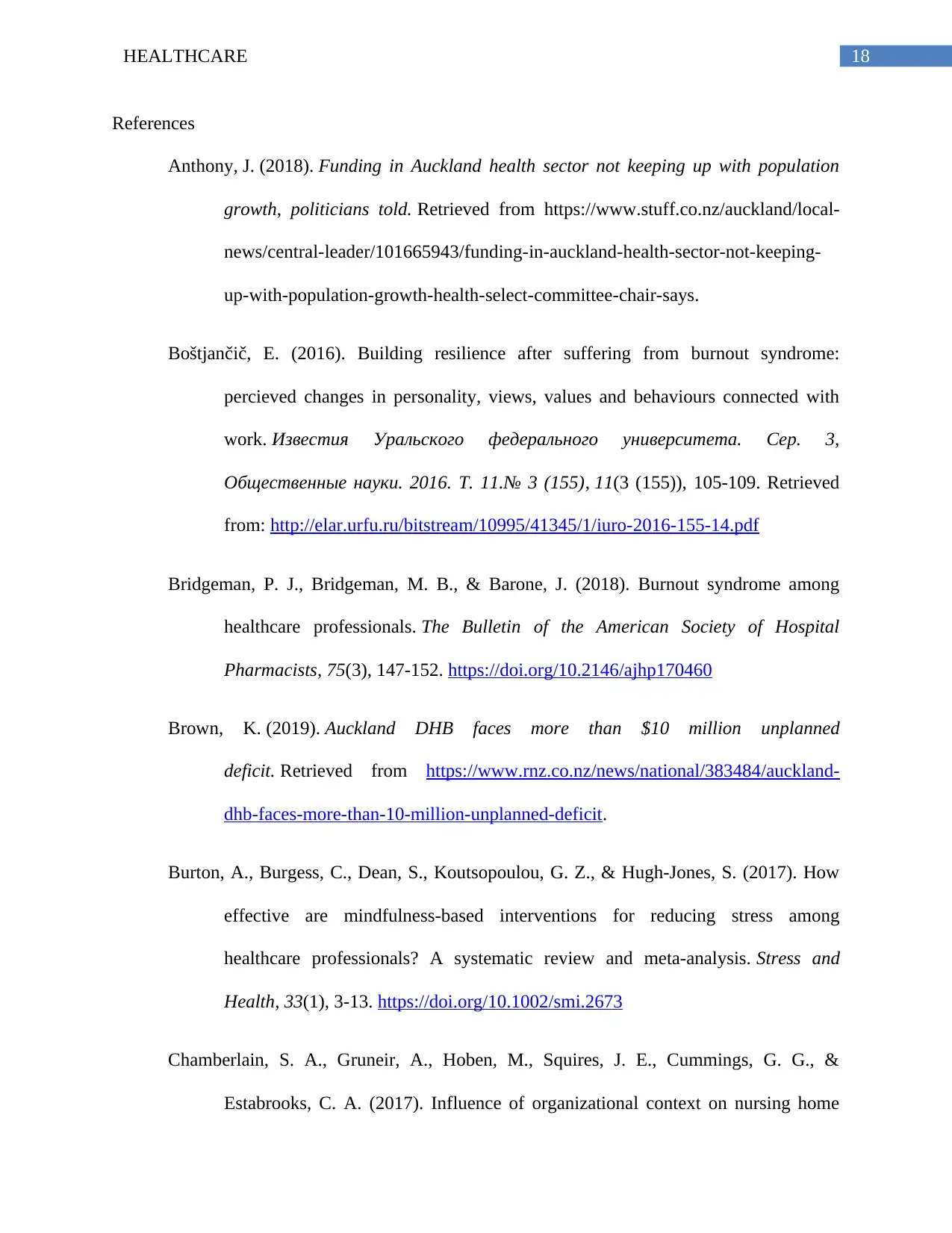
18HEALTHCARE
References
Anthony, J. (2018). Funding in Auckland health sector not keeping up with population
growth, politicians told. Retrieved from https://www.stuff.co.nz/auckland/local-
news/central-leader/101665943/funding-in-auckland-health-sector-not-keeping-
up-with-population-growth-health-select-committee-chair-says.
Boštjančič, E. (2016). Building resilience after suffering from burnout syndrome:
percieved changes in personality, views, values and behaviours connected with
work. Известия Уральского федерального университета. Сер. 3,
Общественные науки. 2016. Т. 11.№ 3 (155), 11(3 (155)), 105-109. Retrieved
from: http://elar.urfu.ru/bitstream/10995/41345/1/iuro-2016-155-14.pdf
Bridgeman, P. J., Bridgeman, M. B., & Barone, J. (2018). Burnout syndrome among
healthcare professionals. The Bulletin of the American Society of Hospital
Pharmacists, 75(3), 147-152. https://doi.org/10.2146/ajhp170460
Brown, K. (2019). Auckland DHB faces more than $10 million unplanned
deficit. Retrieved from https://www.rnz.co.nz/news/national/383484/auckland-
dhb-faces-more-than-10-million-unplanned-deficit.
Burton, A., Burgess, C., Dean, S., Koutsopoulou, G. Z., & Hugh‐Jones, S. (2017). How
effective are mindfulness‐based interventions for reducing stress among
healthcare professionals? A systematic review and meta‐analysis. Stress and
Health, 33(1), 3-13. https://doi.org/10.1002/smi.2673
Chamberlain, S. A., Gruneir, A., Hoben, M., Squires, J. E., Cummings, G. G., &
Estabrooks, C. A. (2017). Influence of organizational context on nursing home
References
Anthony, J. (2018). Funding in Auckland health sector not keeping up with population
growth, politicians told. Retrieved from https://www.stuff.co.nz/auckland/local-
news/central-leader/101665943/funding-in-auckland-health-sector-not-keeping-
up-with-population-growth-health-select-committee-chair-says.
Boštjančič, E. (2016). Building resilience after suffering from burnout syndrome:
percieved changes in personality, views, values and behaviours connected with
work. Известия Уральского федерального университета. Сер. 3,
Общественные науки. 2016. Т. 11.№ 3 (155), 11(3 (155)), 105-109. Retrieved
from: http://elar.urfu.ru/bitstream/10995/41345/1/iuro-2016-155-14.pdf
Bridgeman, P. J., Bridgeman, M. B., & Barone, J. (2018). Burnout syndrome among
healthcare professionals. The Bulletin of the American Society of Hospital
Pharmacists, 75(3), 147-152. https://doi.org/10.2146/ajhp170460
Brown, K. (2019). Auckland DHB faces more than $10 million unplanned
deficit. Retrieved from https://www.rnz.co.nz/news/national/383484/auckland-
dhb-faces-more-than-10-million-unplanned-deficit.
Burton, A., Burgess, C., Dean, S., Koutsopoulou, G. Z., & Hugh‐Jones, S. (2017). How
effective are mindfulness‐based interventions for reducing stress among
healthcare professionals? A systematic review and meta‐analysis. Stress and
Health, 33(1), 3-13. https://doi.org/10.1002/smi.2673
Chamberlain, S. A., Gruneir, A., Hoben, M., Squires, J. E., Cummings, G. G., &
Estabrooks, C. A. (2017). Influence of organizational context on nursing home
Paraphrase This Document
Need a fresh take? Get an instant paraphrase of this document with our AI Paraphraser
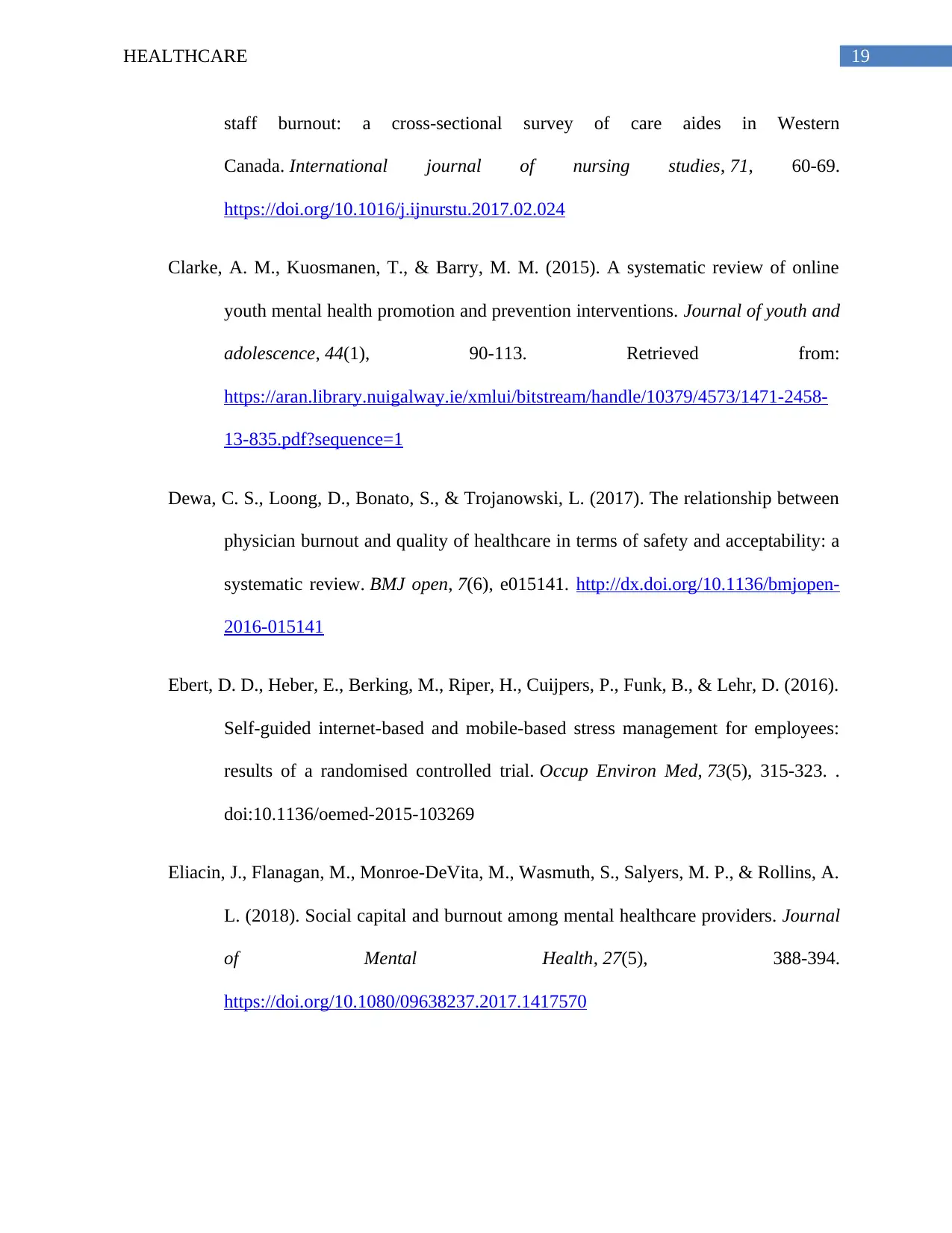
19HEALTHCARE
staff burnout: a cross-sectional survey of care aides in Western
Canada. International journal of nursing studies, 71, 60-69.
https://doi.org/10.1016/j.ijnurstu.2017.02.024
Clarke, A. M., Kuosmanen, T., & Barry, M. M. (2015). A systematic review of online
youth mental health promotion and prevention interventions. Journal of youth and
adolescence, 44(1), 90-113. Retrieved from:
https://aran.library.nuigalway.ie/xmlui/bitstream/handle/10379/4573/1471-2458-
13-835.pdf?sequence=1
Dewa, C. S., Loong, D., Bonato, S., & Trojanowski, L. (2017). The relationship between
physician burnout and quality of healthcare in terms of safety and acceptability: a
systematic review. BMJ open, 7(6), e015141. http://dx.doi.org/10.1136/bmjopen-
2016-015141
Ebert, D. D., Heber, E., Berking, M., Riper, H., Cuijpers, P., Funk, B., & Lehr, D. (2016).
Self-guided internet-based and mobile-based stress management for employees:
results of a randomised controlled trial. Occup Environ Med, 73(5), 315-323. .
doi:10.1136/oemed-2015-103269
Eliacin, J., Flanagan, M., Monroe-DeVita, M., Wasmuth, S., Salyers, M. P., & Rollins, A.
L. (2018). Social capital and burnout among mental healthcare providers. Journal
of Mental Health, 27(5), 388-394.
https://doi.org/10.1080/09638237.2017.1417570
staff burnout: a cross-sectional survey of care aides in Western
Canada. International journal of nursing studies, 71, 60-69.
https://doi.org/10.1016/j.ijnurstu.2017.02.024
Clarke, A. M., Kuosmanen, T., & Barry, M. M. (2015). A systematic review of online
youth mental health promotion and prevention interventions. Journal of youth and
adolescence, 44(1), 90-113. Retrieved from:
https://aran.library.nuigalway.ie/xmlui/bitstream/handle/10379/4573/1471-2458-
13-835.pdf?sequence=1
Dewa, C. S., Loong, D., Bonato, S., & Trojanowski, L. (2017). The relationship between
physician burnout and quality of healthcare in terms of safety and acceptability: a
systematic review. BMJ open, 7(6), e015141. http://dx.doi.org/10.1136/bmjopen-
2016-015141
Ebert, D. D., Heber, E., Berking, M., Riper, H., Cuijpers, P., Funk, B., & Lehr, D. (2016).
Self-guided internet-based and mobile-based stress management for employees:
results of a randomised controlled trial. Occup Environ Med, 73(5), 315-323. .
doi:10.1136/oemed-2015-103269
Eliacin, J., Flanagan, M., Monroe-DeVita, M., Wasmuth, S., Salyers, M. P., & Rollins, A.
L. (2018). Social capital and burnout among mental healthcare providers. Journal
of Mental Health, 27(5), 388-394.
https://doi.org/10.1080/09638237.2017.1417570
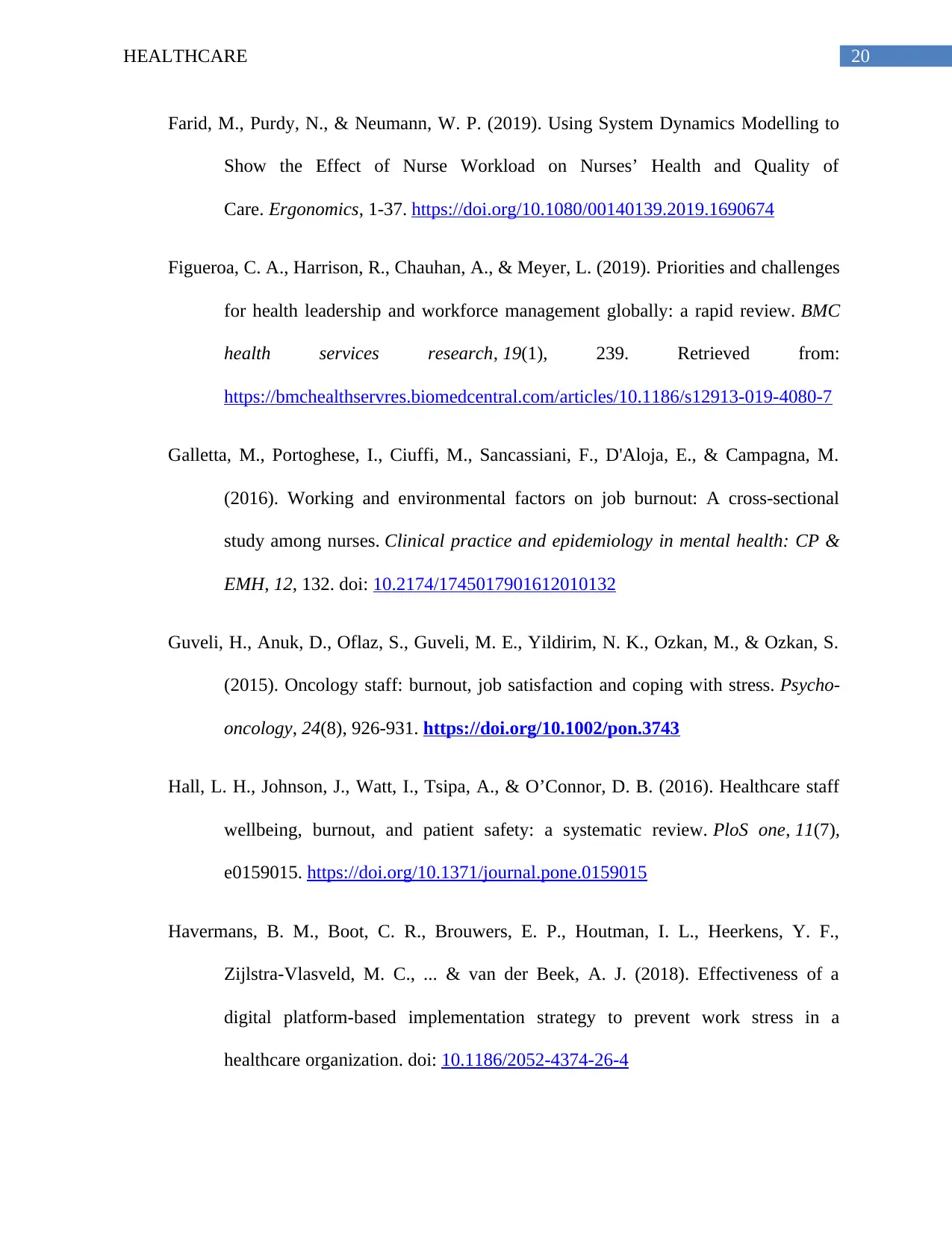
20HEALTHCARE
Farid, M., Purdy, N., & Neumann, W. P. (2019). Using System Dynamics Modelling to
Show the Effect of Nurse Workload on Nurses’ Health and Quality of
Care. Ergonomics, 1-37. https://doi.org/10.1080/00140139.2019.1690674
Figueroa, C. A., Harrison, R., Chauhan, A., & Meyer, L. (2019). Priorities and challenges
for health leadership and workforce management globally: a rapid review. BMC
health services research, 19(1), 239. Retrieved from:
https://bmchealthservres.biomedcentral.com/articles/10.1186/s12913-019-4080-7
Galletta, M., Portoghese, I., Ciuffi, M., Sancassiani, F., D'Aloja, E., & Campagna, M.
(2016). Working and environmental factors on job burnout: A cross-sectional
study among nurses. Clinical practice and epidemiology in mental health: CP &
EMH, 12, 132. doi: 10.2174/1745017901612010132
Guveli, H., Anuk, D., Oflaz, S., Guveli, M. E., Yildirim, N. K., Ozkan, M., & Ozkan, S.
(2015). Oncology staff: burnout, job satisfaction and coping with stress. Psycho‐
oncology, 24(8), 926-931. https://doi.org/10.1002/pon.3743
Hall, L. H., Johnson, J., Watt, I., Tsipa, A., & O’Connor, D. B. (2016). Healthcare staff
wellbeing, burnout, and patient safety: a systematic review. PloS one, 11(7),
e0159015. https://doi.org/10.1371/journal.pone.0159015
Havermans, B. M., Boot, C. R., Brouwers, E. P., Houtman, I. L., Heerkens, Y. F.,
Zijlstra-Vlasveld, M. C., ... & van der Beek, A. J. (2018). Effectiveness of a
digital platform-based implementation strategy to prevent work stress in a
healthcare organization. doi: 10.1186/2052-4374-26-4
Farid, M., Purdy, N., & Neumann, W. P. (2019). Using System Dynamics Modelling to
Show the Effect of Nurse Workload on Nurses’ Health and Quality of
Care. Ergonomics, 1-37. https://doi.org/10.1080/00140139.2019.1690674
Figueroa, C. A., Harrison, R., Chauhan, A., & Meyer, L. (2019). Priorities and challenges
for health leadership and workforce management globally: a rapid review. BMC
health services research, 19(1), 239. Retrieved from:
https://bmchealthservres.biomedcentral.com/articles/10.1186/s12913-019-4080-7
Galletta, M., Portoghese, I., Ciuffi, M., Sancassiani, F., D'Aloja, E., & Campagna, M.
(2016). Working and environmental factors on job burnout: A cross-sectional
study among nurses. Clinical practice and epidemiology in mental health: CP &
EMH, 12, 132. doi: 10.2174/1745017901612010132
Guveli, H., Anuk, D., Oflaz, S., Guveli, M. E., Yildirim, N. K., Ozkan, M., & Ozkan, S.
(2015). Oncology staff: burnout, job satisfaction and coping with stress. Psycho‐
oncology, 24(8), 926-931. https://doi.org/10.1002/pon.3743
Hall, L. H., Johnson, J., Watt, I., Tsipa, A., & O’Connor, D. B. (2016). Healthcare staff
wellbeing, burnout, and patient safety: a systematic review. PloS one, 11(7),
e0159015. https://doi.org/10.1371/journal.pone.0159015
Havermans, B. M., Boot, C. R., Brouwers, E. P., Houtman, I. L., Heerkens, Y. F.,
Zijlstra-Vlasveld, M. C., ... & van der Beek, A. J. (2018). Effectiveness of a
digital platform-based implementation strategy to prevent work stress in a
healthcare organization. doi: 10.1186/2052-4374-26-4
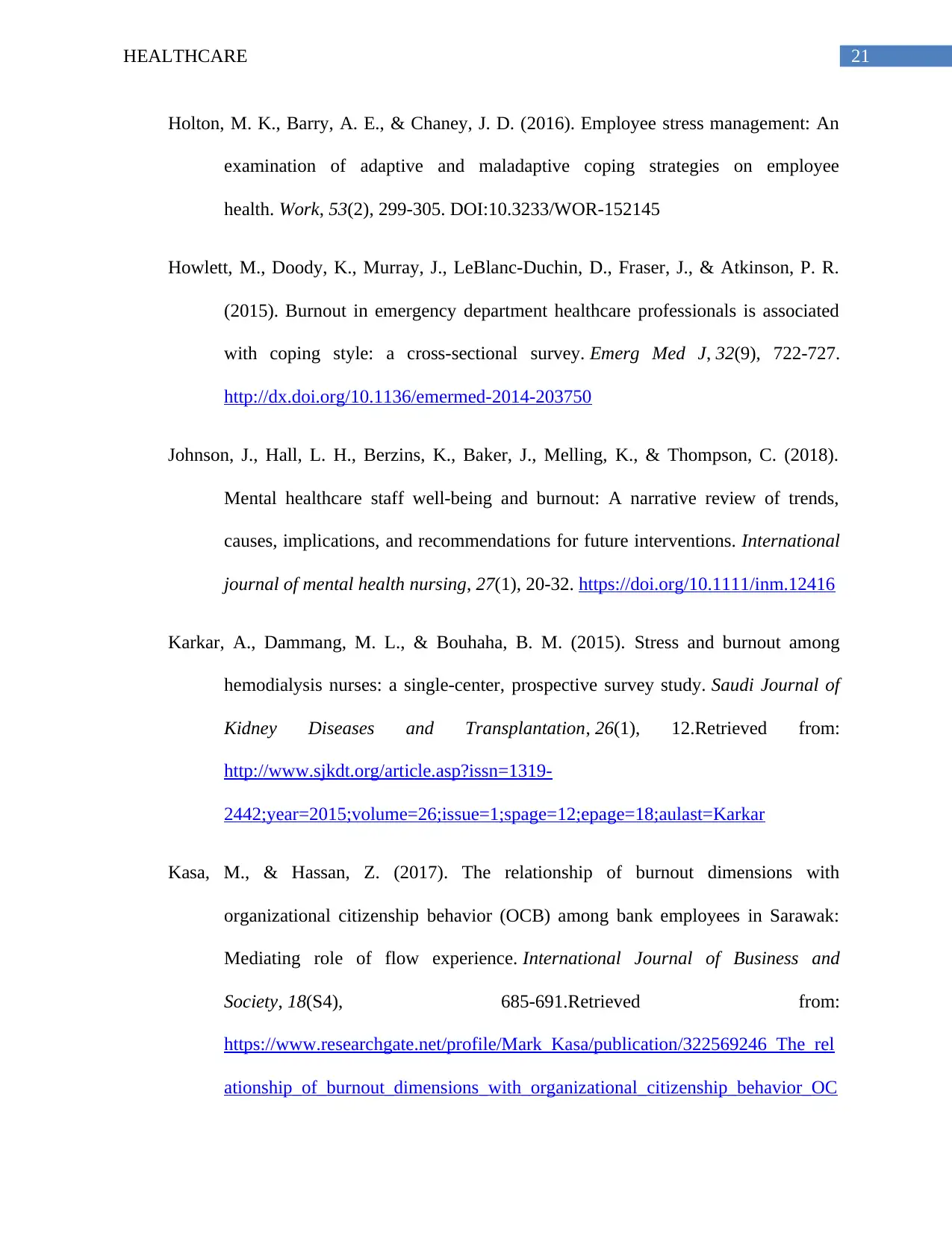
21HEALTHCARE
Holton, M. K., Barry, A. E., & Chaney, J. D. (2016). Employee stress management: An
examination of adaptive and maladaptive coping strategies on employee
health. Work, 53(2), 299-305. DOI:10.3233/WOR-152145
Howlett, M., Doody, K., Murray, J., LeBlanc-Duchin, D., Fraser, J., & Atkinson, P. R.
(2015). Burnout in emergency department healthcare professionals is associated
with coping style: a cross-sectional survey. Emerg Med J, 32(9), 722-727.
http://dx.doi.org/10.1136/emermed-2014-203750
Johnson, J., Hall, L. H., Berzins, K., Baker, J., Melling, K., & Thompson, C. (2018).
Mental healthcare staff well‐being and burnout: A narrative review of trends,
causes, implications, and recommendations for future interventions. International
journal of mental health nursing, 27(1), 20-32. https://doi.org/10.1111/inm.12416
Karkar, A., Dammang, M. L., & Bouhaha, B. M. (2015). Stress and burnout among
hemodialysis nurses: a single-center, prospective survey study. Saudi Journal of
Kidney Diseases and Transplantation, 26(1), 12.Retrieved from:
http://www.sjkdt.org/article.asp?issn=1319-
2442;year=2015;volume=26;issue=1;spage=12;epage=18;aulast=Karkar
Kasa, M., & Hassan, Z. (2017). The relationship of burnout dimensions with
organizational citizenship behavior (OCB) among bank employees in Sarawak:
Mediating role of flow experience. International Journal of Business and
Society, 18(S4), 685-691.Retrieved from:
https://www.researchgate.net/profile/Mark_Kasa/publication/322569246_The_rel
ationship_of_burnout_dimensions_with_organizational_citizenship_behavior_OC
Holton, M. K., Barry, A. E., & Chaney, J. D. (2016). Employee stress management: An
examination of adaptive and maladaptive coping strategies on employee
health. Work, 53(2), 299-305. DOI:10.3233/WOR-152145
Howlett, M., Doody, K., Murray, J., LeBlanc-Duchin, D., Fraser, J., & Atkinson, P. R.
(2015). Burnout in emergency department healthcare professionals is associated
with coping style: a cross-sectional survey. Emerg Med J, 32(9), 722-727.
http://dx.doi.org/10.1136/emermed-2014-203750
Johnson, J., Hall, L. H., Berzins, K., Baker, J., Melling, K., & Thompson, C. (2018).
Mental healthcare staff well‐being and burnout: A narrative review of trends,
causes, implications, and recommendations for future interventions. International
journal of mental health nursing, 27(1), 20-32. https://doi.org/10.1111/inm.12416
Karkar, A., Dammang, M. L., & Bouhaha, B. M. (2015). Stress and burnout among
hemodialysis nurses: a single-center, prospective survey study. Saudi Journal of
Kidney Diseases and Transplantation, 26(1), 12.Retrieved from:
http://www.sjkdt.org/article.asp?issn=1319-
2442;year=2015;volume=26;issue=1;spage=12;epage=18;aulast=Karkar
Kasa, M., & Hassan, Z. (2017). The relationship of burnout dimensions with
organizational citizenship behavior (OCB) among bank employees in Sarawak:
Mediating role of flow experience. International Journal of Business and
Society, 18(S4), 685-691.Retrieved from:
https://www.researchgate.net/profile/Mark_Kasa/publication/322569246_The_rel
ationship_of_burnout_dimensions_with_organizational_citizenship_behavior_OC
Secure Best Marks with AI Grader
Need help grading? Try our AI Grader for instant feedback on your assignments.
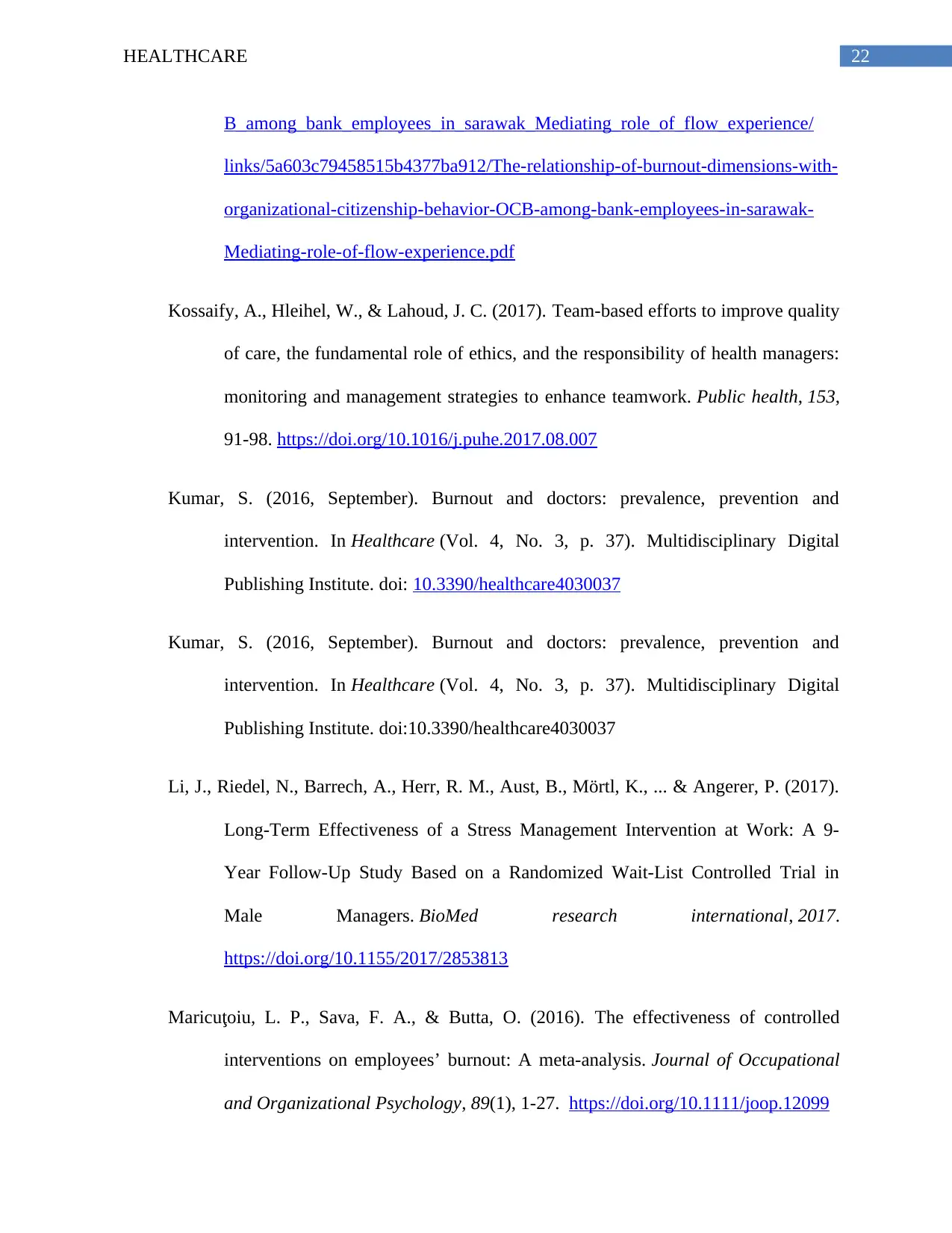
22HEALTHCARE
B_among_bank_employees_in_sarawak_Mediating_role_of_flow_experience/
links/5a603c79458515b4377ba912/The-relationship-of-burnout-dimensions-with-
organizational-citizenship-behavior-OCB-among-bank-employees-in-sarawak-
Mediating-role-of-flow-experience.pdf
Kossaify, A., Hleihel, W., & Lahoud, J. C. (2017). Team-based efforts to improve quality
of care, the fundamental role of ethics, and the responsibility of health managers:
monitoring and management strategies to enhance teamwork. Public health, 153,
91-98. https://doi.org/10.1016/j.puhe.2017.08.007
Kumar, S. (2016, September). Burnout and doctors: prevalence, prevention and
intervention. In Healthcare (Vol. 4, No. 3, p. 37). Multidisciplinary Digital
Publishing Institute. doi: 10.3390/healthcare4030037
Kumar, S. (2016, September). Burnout and doctors: prevalence, prevention and
intervention. In Healthcare (Vol. 4, No. 3, p. 37). Multidisciplinary Digital
Publishing Institute. doi:10.3390/healthcare4030037
Li, J., Riedel, N., Barrech, A., Herr, R. M., Aust, B., Mörtl, K., ... & Angerer, P. (2017).
Long-Term Effectiveness of a Stress Management Intervention at Work: A 9-
Year Follow-Up Study Based on a Randomized Wait-List Controlled Trial in
Male Managers. BioMed research international, 2017.
https://doi.org/10.1155/2017/2853813
Maricuţoiu, L. P., Sava, F. A., & Butta, O. (2016). The effectiveness of controlled
interventions on employees’ burnout: A meta‐analysis. Journal of Occupational
and Organizational Psychology, 89(1), 1-27. https://doi.org/10.1111/joop.12099
B_among_bank_employees_in_sarawak_Mediating_role_of_flow_experience/
links/5a603c79458515b4377ba912/The-relationship-of-burnout-dimensions-with-
organizational-citizenship-behavior-OCB-among-bank-employees-in-sarawak-
Mediating-role-of-flow-experience.pdf
Kossaify, A., Hleihel, W., & Lahoud, J. C. (2017). Team-based efforts to improve quality
of care, the fundamental role of ethics, and the responsibility of health managers:
monitoring and management strategies to enhance teamwork. Public health, 153,
91-98. https://doi.org/10.1016/j.puhe.2017.08.007
Kumar, S. (2016, September). Burnout and doctors: prevalence, prevention and
intervention. In Healthcare (Vol. 4, No. 3, p. 37). Multidisciplinary Digital
Publishing Institute. doi: 10.3390/healthcare4030037
Kumar, S. (2016, September). Burnout and doctors: prevalence, prevention and
intervention. In Healthcare (Vol. 4, No. 3, p. 37). Multidisciplinary Digital
Publishing Institute. doi:10.3390/healthcare4030037
Li, J., Riedel, N., Barrech, A., Herr, R. M., Aust, B., Mörtl, K., ... & Angerer, P. (2017).
Long-Term Effectiveness of a Stress Management Intervention at Work: A 9-
Year Follow-Up Study Based on a Randomized Wait-List Controlled Trial in
Male Managers. BioMed research international, 2017.
https://doi.org/10.1155/2017/2853813
Maricuţoiu, L. P., Sava, F. A., & Butta, O. (2016). The effectiveness of controlled
interventions on employees’ burnout: A meta‐analysis. Journal of Occupational
and Organizational Psychology, 89(1), 1-27. https://doi.org/10.1111/joop.12099
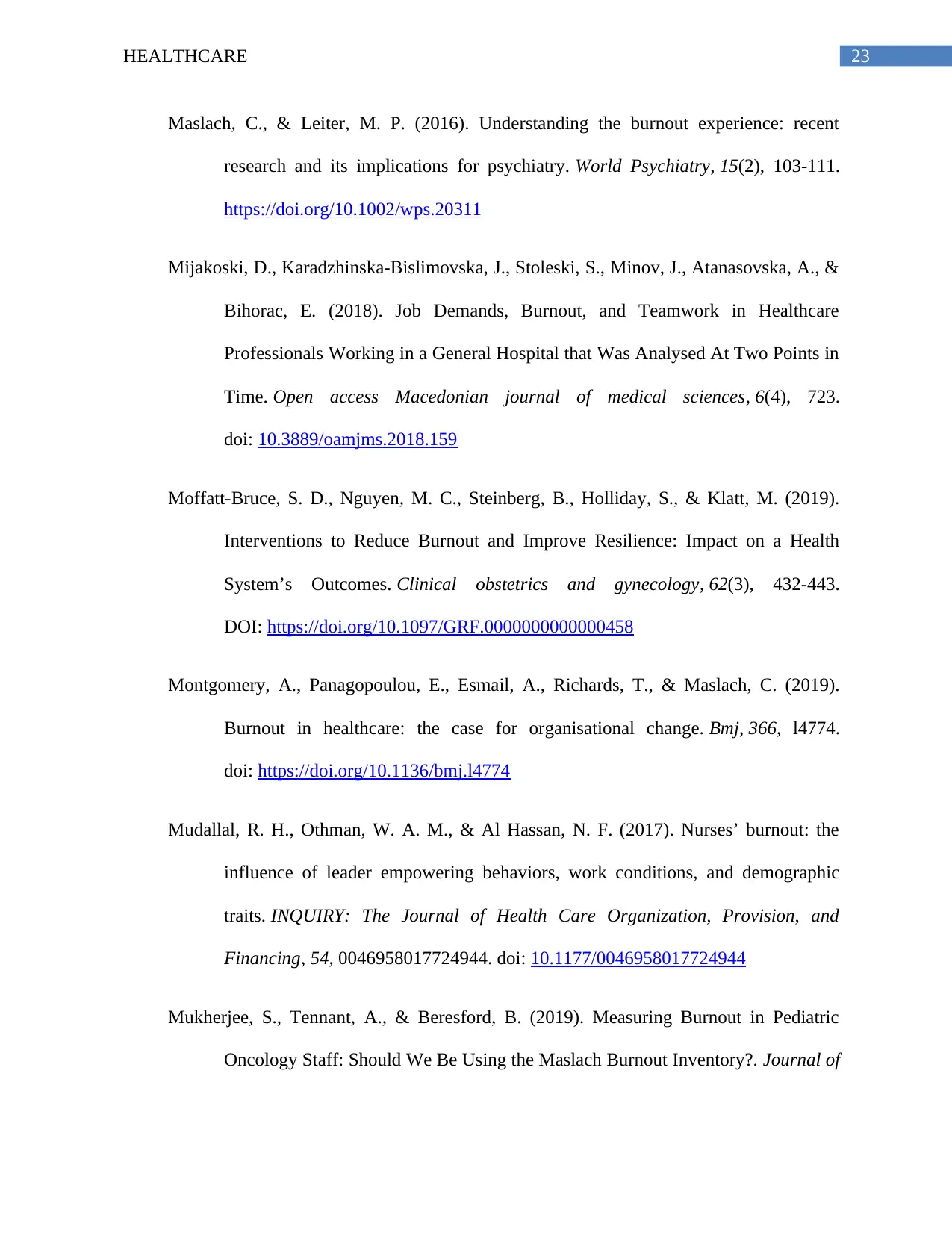
23HEALTHCARE
Maslach, C., & Leiter, M. P. (2016). Understanding the burnout experience: recent
research and its implications for psychiatry. World Psychiatry, 15(2), 103-111.
https://doi.org/10.1002/wps.20311
Mijakoski, D., Karadzhinska-Bislimovska, J., Stoleski, S., Minov, J., Atanasovska, A., &
Bihorac, E. (2018). Job Demands, Burnout, and Teamwork in Healthcare
Professionals Working in a General Hospital that Was Analysed At Two Points in
Time. Open access Macedonian journal of medical sciences, 6(4), 723.
doi: 10.3889/oamjms.2018.159
Moffatt-Bruce, S. D., Nguyen, M. C., Steinberg, B., Holliday, S., & Klatt, M. (2019).
Interventions to Reduce Burnout and Improve Resilience: Impact on a Health
System’s Outcomes. Clinical obstetrics and gynecology, 62(3), 432-443.
DOI: https://doi.org/10.1097/GRF.0000000000000458
Montgomery, A., Panagopoulou, E., Esmail, A., Richards, T., & Maslach, C. (2019).
Burnout in healthcare: the case for organisational change. Bmj, 366, l4774.
doi: https://doi.org/10.1136/bmj.l4774
Mudallal, R. H., Othman, W. A. M., & Al Hassan, N. F. (2017). Nurses’ burnout: the
influence of leader empowering behaviors, work conditions, and demographic
traits. INQUIRY: The Journal of Health Care Organization, Provision, and
Financing, 54, 0046958017724944. doi: 10.1177/0046958017724944
Mukherjee, S., Tennant, A., & Beresford, B. (2019). Measuring Burnout in Pediatric
Oncology Staff: Should We Be Using the Maslach Burnout Inventory?. Journal of
Maslach, C., & Leiter, M. P. (2016). Understanding the burnout experience: recent
research and its implications for psychiatry. World Psychiatry, 15(2), 103-111.
https://doi.org/10.1002/wps.20311
Mijakoski, D., Karadzhinska-Bislimovska, J., Stoleski, S., Minov, J., Atanasovska, A., &
Bihorac, E. (2018). Job Demands, Burnout, and Teamwork in Healthcare
Professionals Working in a General Hospital that Was Analysed At Two Points in
Time. Open access Macedonian journal of medical sciences, 6(4), 723.
doi: 10.3889/oamjms.2018.159
Moffatt-Bruce, S. D., Nguyen, M. C., Steinberg, B., Holliday, S., & Klatt, M. (2019).
Interventions to Reduce Burnout and Improve Resilience: Impact on a Health
System’s Outcomes. Clinical obstetrics and gynecology, 62(3), 432-443.
DOI: https://doi.org/10.1097/GRF.0000000000000458
Montgomery, A., Panagopoulou, E., Esmail, A., Richards, T., & Maslach, C. (2019).
Burnout in healthcare: the case for organisational change. Bmj, 366, l4774.
doi: https://doi.org/10.1136/bmj.l4774
Mudallal, R. H., Othman, W. A. M., & Al Hassan, N. F. (2017). Nurses’ burnout: the
influence of leader empowering behaviors, work conditions, and demographic
traits. INQUIRY: The Journal of Health Care Organization, Provision, and
Financing, 54, 0046958017724944. doi: 10.1177/0046958017724944
Mukherjee, S., Tennant, A., & Beresford, B. (2019). Measuring Burnout in Pediatric
Oncology Staff: Should We Be Using the Maslach Burnout Inventory?. Journal of
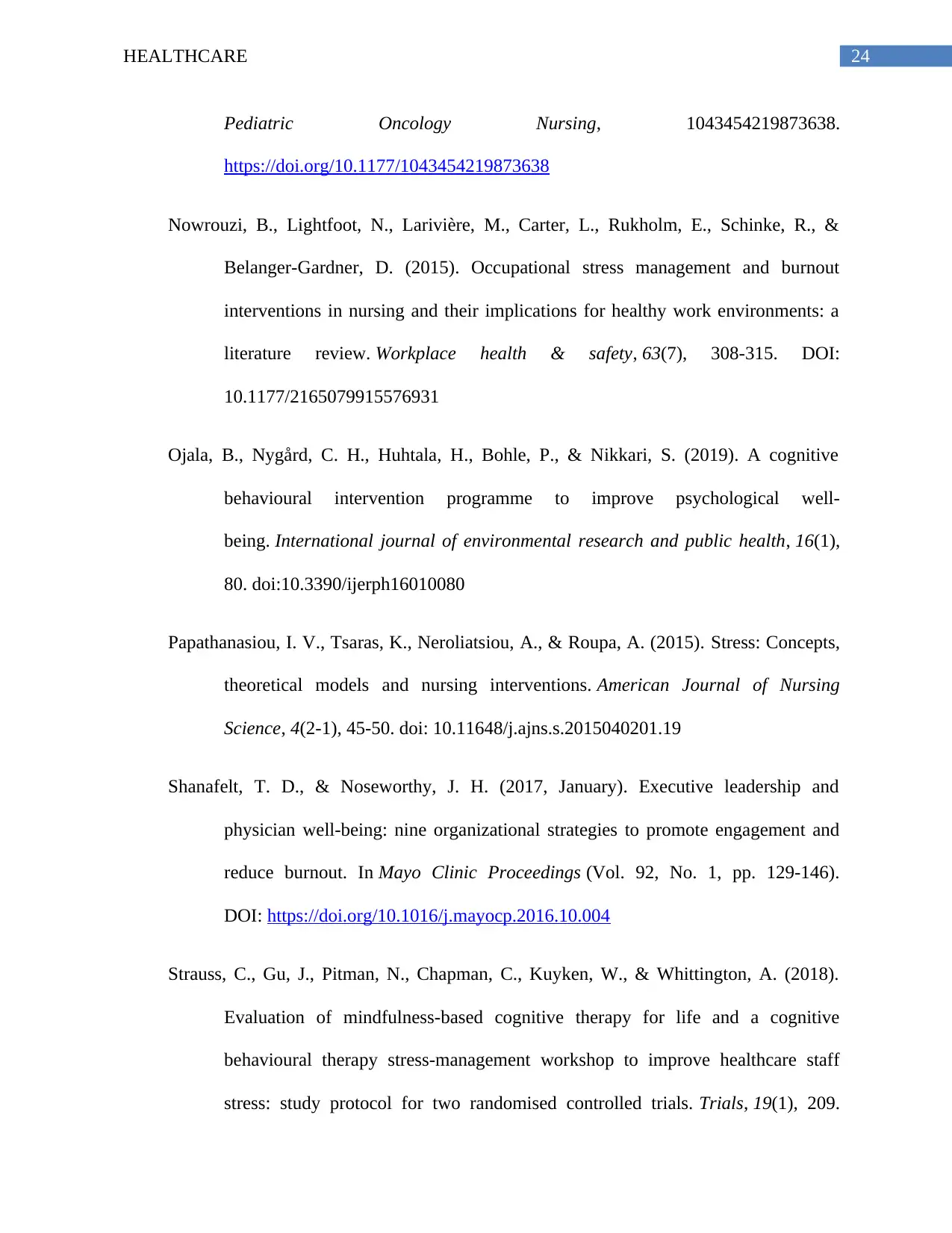
24HEALTHCARE
Pediatric Oncology Nursing, 1043454219873638.
https://doi.org/10.1177/1043454219873638
Nowrouzi, B., Lightfoot, N., Larivière, M., Carter, L., Rukholm, E., Schinke, R., &
Belanger-Gardner, D. (2015). Occupational stress management and burnout
interventions in nursing and their implications for healthy work environments: a
literature review. Workplace health & safety, 63(7), 308-315. DOI:
10.1177/2165079915576931
Ojala, B., Nygård, C. H., Huhtala, H., Bohle, P., & Nikkari, S. (2019). A cognitive
behavioural intervention programme to improve psychological well-
being. International journal of environmental research and public health, 16(1),
80. doi:10.3390/ijerph16010080
Papathanasiou, I. V., Tsaras, K., Neroliatsiou, A., & Roupa, A. (2015). Stress: Concepts,
theoretical models and nursing interventions. American Journal of Nursing
Science, 4(2-1), 45-50. doi: 10.11648/j.ajns.s.2015040201.19
Shanafelt, T. D., & Noseworthy, J. H. (2017, January). Executive leadership and
physician well-being: nine organizational strategies to promote engagement and
reduce burnout. In Mayo Clinic Proceedings (Vol. 92, No. 1, pp. 129-146).
DOI: https://doi.org/10.1016/j.mayocp.2016.10.004
Strauss, C., Gu, J., Pitman, N., Chapman, C., Kuyken, W., & Whittington, A. (2018).
Evaluation of mindfulness-based cognitive therapy for life and a cognitive
behavioural therapy stress-management workshop to improve healthcare staff
stress: study protocol for two randomised controlled trials. Trials, 19(1), 209.
Pediatric Oncology Nursing, 1043454219873638.
https://doi.org/10.1177/1043454219873638
Nowrouzi, B., Lightfoot, N., Larivière, M., Carter, L., Rukholm, E., Schinke, R., &
Belanger-Gardner, D. (2015). Occupational stress management and burnout
interventions in nursing and their implications for healthy work environments: a
literature review. Workplace health & safety, 63(7), 308-315. DOI:
10.1177/2165079915576931
Ojala, B., Nygård, C. H., Huhtala, H., Bohle, P., & Nikkari, S. (2019). A cognitive
behavioural intervention programme to improve psychological well-
being. International journal of environmental research and public health, 16(1),
80. doi:10.3390/ijerph16010080
Papathanasiou, I. V., Tsaras, K., Neroliatsiou, A., & Roupa, A. (2015). Stress: Concepts,
theoretical models and nursing interventions. American Journal of Nursing
Science, 4(2-1), 45-50. doi: 10.11648/j.ajns.s.2015040201.19
Shanafelt, T. D., & Noseworthy, J. H. (2017, January). Executive leadership and
physician well-being: nine organizational strategies to promote engagement and
reduce burnout. In Mayo Clinic Proceedings (Vol. 92, No. 1, pp. 129-146).
DOI: https://doi.org/10.1016/j.mayocp.2016.10.004
Strauss, C., Gu, J., Pitman, N., Chapman, C., Kuyken, W., & Whittington, A. (2018).
Evaluation of mindfulness-based cognitive therapy for life and a cognitive
behavioural therapy stress-management workshop to improve healthcare staff
stress: study protocol for two randomised controlled trials. Trials, 19(1), 209.
Paraphrase This Document
Need a fresh take? Get an instant paraphrase of this document with our AI Paraphraser
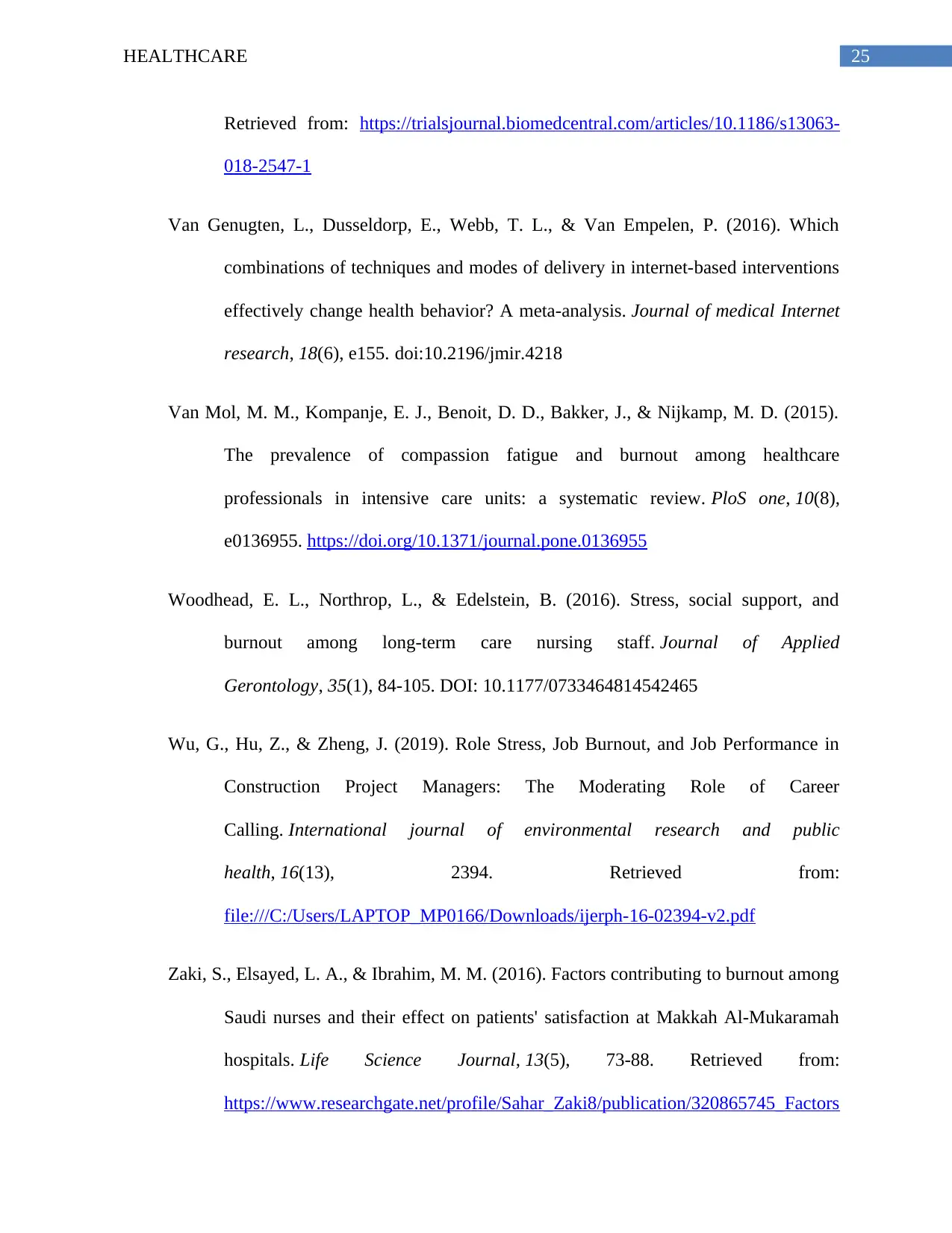
25HEALTHCARE
Retrieved from: https://trialsjournal.biomedcentral.com/articles/10.1186/s13063-
018-2547-1
Van Genugten, L., Dusseldorp, E., Webb, T. L., & Van Empelen, P. (2016). Which
combinations of techniques and modes of delivery in internet-based interventions
effectively change health behavior? A meta-analysis. Journal of medical Internet
research, 18(6), e155. doi:10.2196/jmir.4218
Van Mol, M. M., Kompanje, E. J., Benoit, D. D., Bakker, J., & Nijkamp, M. D. (2015).
The prevalence of compassion fatigue and burnout among healthcare
professionals in intensive care units: a systematic review. PloS one, 10(8),
e0136955. https://doi.org/10.1371/journal.pone.0136955
Woodhead, E. L., Northrop, L., & Edelstein, B. (2016). Stress, social support, and
burnout among long-term care nursing staff. Journal of Applied
Gerontology, 35(1), 84-105. DOI: 10.1177/0733464814542465
Wu, G., Hu, Z., & Zheng, J. (2019). Role Stress, Job Burnout, and Job Performance in
Construction Project Managers: The Moderating Role of Career
Calling. International journal of environmental research and public
health, 16(13), 2394. Retrieved from:
file:///C:/Users/LAPTOP_MP0166/Downloads/ijerph-16-02394-v2.pdf
Zaki, S., Elsayed, L. A., & Ibrahim, M. M. (2016). Factors contributing to burnout among
Saudi nurses and their effect on patients' satisfaction at Makkah Al-Mukaramah
hospitals. Life Science Journal, 13(5), 73-88. Retrieved from:
https://www.researchgate.net/profile/Sahar_Zaki8/publication/320865745_Factors
Retrieved from: https://trialsjournal.biomedcentral.com/articles/10.1186/s13063-
018-2547-1
Van Genugten, L., Dusseldorp, E., Webb, T. L., & Van Empelen, P. (2016). Which
combinations of techniques and modes of delivery in internet-based interventions
effectively change health behavior? A meta-analysis. Journal of medical Internet
research, 18(6), e155. doi:10.2196/jmir.4218
Van Mol, M. M., Kompanje, E. J., Benoit, D. D., Bakker, J., & Nijkamp, M. D. (2015).
The prevalence of compassion fatigue and burnout among healthcare
professionals in intensive care units: a systematic review. PloS one, 10(8),
e0136955. https://doi.org/10.1371/journal.pone.0136955
Woodhead, E. L., Northrop, L., & Edelstein, B. (2016). Stress, social support, and
burnout among long-term care nursing staff. Journal of Applied
Gerontology, 35(1), 84-105. DOI: 10.1177/0733464814542465
Wu, G., Hu, Z., & Zheng, J. (2019). Role Stress, Job Burnout, and Job Performance in
Construction Project Managers: The Moderating Role of Career
Calling. International journal of environmental research and public
health, 16(13), 2394. Retrieved from:
file:///C:/Users/LAPTOP_MP0166/Downloads/ijerph-16-02394-v2.pdf
Zaki, S., Elsayed, L. A., & Ibrahim, M. M. (2016). Factors contributing to burnout among
Saudi nurses and their effect on patients' satisfaction at Makkah Al-Mukaramah
hospitals. Life Science Journal, 13(5), 73-88. Retrieved from:
https://www.researchgate.net/profile/Sahar_Zaki8/publication/320865745_Factors
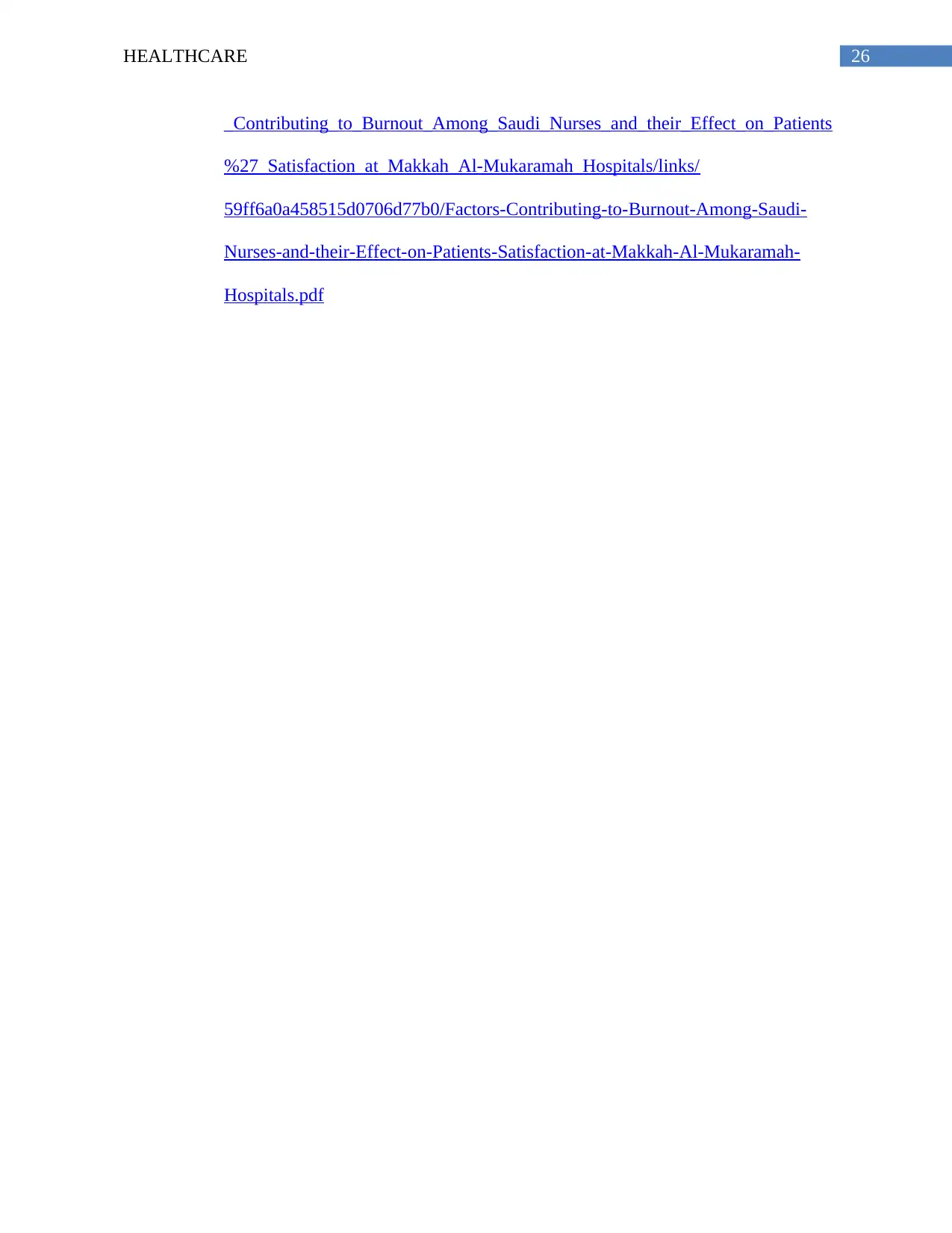
26HEALTHCARE
_Contributing_to_Burnout_Among_Saudi_Nurses_and_their_Effect_on_Patients
%27_Satisfaction_at_Makkah_Al-Mukaramah_Hospitals/links/
59ff6a0a458515d0706d77b0/Factors-Contributing-to-Burnout-Among-Saudi-
Nurses-and-their-Effect-on-Patients-Satisfaction-at-Makkah-Al-Mukaramah-
Hospitals.pdf
_Contributing_to_Burnout_Among_Saudi_Nurses_and_their_Effect_on_Patients
%27_Satisfaction_at_Makkah_Al-Mukaramah_Hospitals/links/
59ff6a0a458515d0706d77b0/Factors-Contributing-to-Burnout-Among-Saudi-
Nurses-and-their-Effect-on-Patients-Satisfaction-at-Makkah-Al-Mukaramah-
Hospitals.pdf
1 out of 27
Related Documents
Your All-in-One AI-Powered Toolkit for Academic Success.
+13062052269
info@desklib.com
Available 24*7 on WhatsApp / Email
![[object Object]](/_next/static/media/star-bottom.7253800d.svg)
Unlock your academic potential
© 2024 | Zucol Services PVT LTD | All rights reserved.



